Red Tide by Traveller
Welcome to the jungle
Original SA post Red TideWelcome to the jungle
And on that note, let's continue with the Kevin Crawford love! Red Tide is his setting for the Labyrinth Lord retroclone. LL is specifically a retroclone of the 1981 Basic/Expert edition of D&D, also known as Moldvay/Cook D&D: all that you have to really have to know is that in LL Elf, Dwarf and Halfling are classes of their own. Red Tide is a sandbox setting where the last remainders of civilization eke out a living in a hostile archipelago, trapped along with savage natives and the dangers of the isles by a malevolent, cosmic force. Handily, this also limits the size of the sandbox to manageable levels, and as the review progresses we'll see that Crawford really tried everything to make sandbox gaming not just appealing, but as easy to run and play in as possible.
But first, we're going to get some background!
quote:
Three hundred years ago, the world ended.
Okay, so this world used to have its bog-standard collection of realms, kingdoms and empires. It was an ordinary fantasy world, as far as these things go. One day, Archmage Lammach , First Seer of the Ninefold Celestial Empire, saw omens of a dire fate. Only thing was, he was the only diviner to see them, and therefore no one else believed him despite his exalted status. The omens were so horrible, however, that Lammach took it upon himself to build a fleet that could carry refugees to the only place he saw would be a refuge from the coming apocalypse, an isolated collection of islands loved by pirates, smugglers and other ne'er-do-wells. The effort to which Lammach went was enough that some people started taking notice, but it would be too late.
East of the empire, the Red Tide appeared. The Tide was as tall as a city wall, an encroaching mist from which things that were not of this world crawled forth. Its advance was relentless, consuming everything in its path. The Emperor finally accepted that Lammach had been right, but by then there was little to do but flee to the western ports and secure passage on one of his fleet's ships. The last command Lammach received from his liege was taking the Tablet of Heaven and the treasures of the Empire with him and flee. The Emperor stayed behind with his greatest sorcerers to buy the fleet as much time as they could. And so, refugees from all over the world abandoned their homelands to the Tide, heading to the only place in the world that would be safe from it for centuries: the Sunset Isles.
The Isles were a backwater. Some empires of old had tried conquering, but they were too far away and had too little of value. Sure, there were ruins and such, but nothing really worth mobilizing forces. As such, the Isles were a haven for exiles, pirates and other outlaws. Some tried colonizing the isles, too: most of those ended up as fodder for the native inhabitants of the isles, the warlike Shou. But to the Isles the refugee fleet went all the same, because Lammach saw that something in them was inimical to the tide. There were great veins of glossy black stone deep beneath the isles that the Shou called godbone , and something about it made the Tide recoil. Eventually, the fleet made landfall in Ektau , the largest of the isles, and in a short period of time (aided by the Imperial sorcerers that had gone with Lammach) they erected a new city, Xian , over the ruins of ancient settlements. The neighboring Shou would have normally crushed any settler expedition, but the refugees were desperate from their escape, and thus drove the native tribes westward, clearing large swathes of land for their own use. Many settlers died in the coming years to the perils of the Isles, but little by little they started rebuilding what they had lost. They had some help from the local non-Shou inhabitants, particularly from the small and relatively safe port of Nordheim , which was used as a waystation for trade ships back in the day. This knowledge and the settler's coordination helped push the tribes back, as they had little in the way of unity: each single tribe believed they and they alone were the chosen of their god, Shakun , and they thought little of stabbing each other in the back as well as fighting the settlers. Lammach's divinations helped the exiles strike at the Shou's disunity, and so the Clearing Wars went well for them despite the Shou's ferocity and the might of their witch-priestesses.
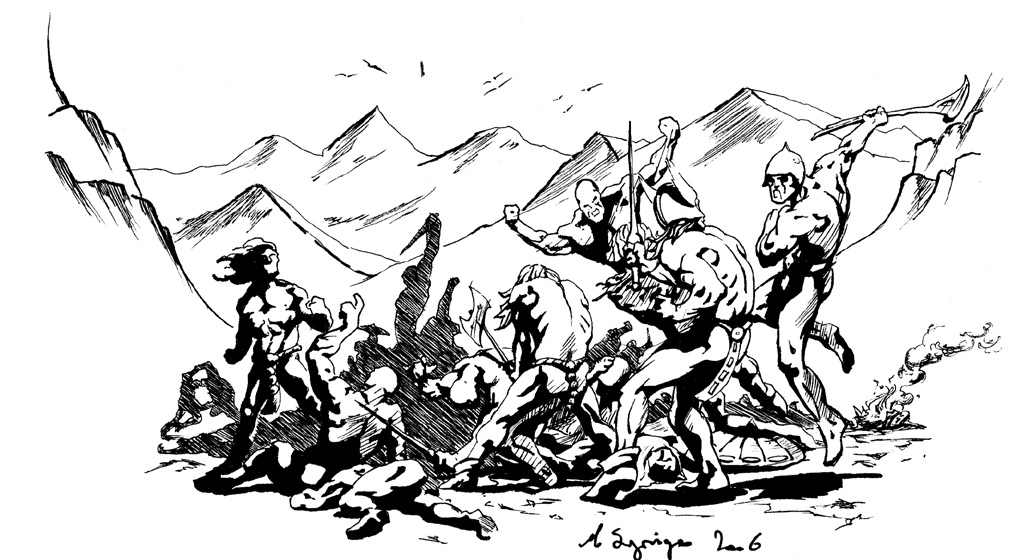
Punch time, motherfucker.
Unfortunately, Lammach himself fell to a desperate, suicidal strike by the Shou. His son was appointed the Mandarin of Xian, and his line continues to rule the city-state today. The death of the archmage blunted the settlers' advance, and so everything ground to a quiet, fitful halt. Some thirty years after the initial landing, three other cities were built in Ektau. To the north, the Kueh (fantasy Japanese) raised the port of Kitaminato . where the old ways of their kind could be preserved - though it bears saying that most of the surviving Kueh were fishermen and peasants, not blue-blooded aristocrats, so their 'old ways' had quite the bit of invention to them. Its ruler was Archmage Rai , who was content to follow the lead of the Mandarin as long as Xian did not interfere unduly with Kitaminato's affairs. To the northwest, Eirengarder (fantasy German/Swiss) built the grey-walled city of Hohnberg . It was a military minded city, a bulwark against the Shou, as befitted the character of its builders. The Eirengarders had a proud military tradition, and the Thusundi (ruler) of Hohnberg owed allegiance to the Mandarin but in a practical way: unity between the cities helped them withstand the Shou better, so the Mandarin did not push Hohnberg too hard. And finally, Tien Lung was built in the sweltering jungles of the southern coast. It started as a magical college built by some of the remaining arcanists and magic-users, afraid that their lore would be lost in the chaos, but soon enough hangers-on showed up that it became a city of its own right. The surrounding terrain was superb for growing medicinal, alchemical and
 plants, and the
Enlightened Sage
that led the Academy of Refulgent Wisdom grew to be almost the equal of the Mandarin in influence. And of course, many other lesser towns, hamlets and villages grew around these cities, particularly in the territory between Tien Lung and Hohnberg, that would later be known as the
Westmark.
plants, and the
Enlightened Sage
that led the Academy of Refulgent Wisdom grew to be almost the equal of the Mandarin in influence. And of course, many other lesser towns, hamlets and villages grew around these cities, particularly in the territory between Tien Lung and Hohnberg, that would later be known as the
Westmark.
It was not to last.
In 120 AL (After Landing), the witch queen Agrathi of the Shou united the warring tribes by persuasion and witchcraft and led them on a grand Ravaging of the hated intruders. The Westmark was smashed by the horde, and there were just not enough heroes and capable people to drive them back. The Hohnbergers were only saved because they held the line long enough for the horde to find easier prey, but they wouldn't have been a match for the full might of the Shou. The other cities paid a terrible price for their survival. Tien Lung's sorcered conjured forbidden arts that fed on the life energies of sacrifices to fuel the magic necessary to drive the Shou back, but by the time the horde receded only one in ten citizens remained. The need to repopulate Tien Lung and find labor made the practice of slavery common in the city, and now Tien Lung is a blighted place. In Kitaminato, archmage Rai (still alive, clinging to life with alchemy and magical research) made a dark pact with the Hell Kings , the demons of the plane, and an unholy horde slaughtered the invaders. But the souls of everyone in the city were the price to pay, and Rai became the undying Shogun of Kitaminato to better enforce the will of his dark lords and secure sacrifices for them. And in Xian, where the horde struck deepest and hardest, the local sorcerers even undertook the taboo practice of raising the dead to fight off the Shou, but not even dead legions could hold the horde back. Cut off from the other cities and from their dwarven allies, it looked like the Shou would succeed in driving the exiles to the sea. Ultimately, an unlikely group of unknown adventurers undertook a suicidal mission to kill Agrathi, and without the witch-queen's influence the horde broke apart and was cast away by forces from Hohnberg, Tien Lung and Xian. And so the exile civilization survived, but now no longer united under the Mandarin of Xian, and the horrible prices paid for their survival made them all wary and mistrustful of each other. The Thusundi and the Enlightened Sage only paid lip service to the Mandarin, and the Shogun issued harsh demands of his own that pleased absolutely no one.
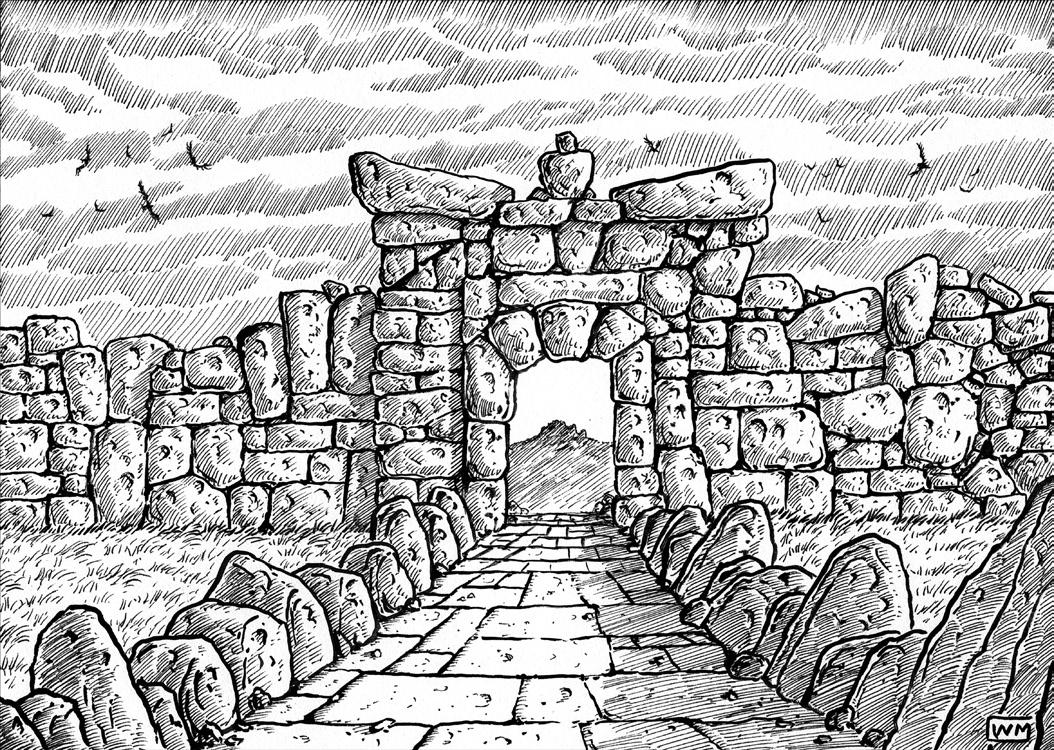
A gate to nowhere? Dunno, just wanted to break the wall of text.
Civilization has recovered somewhat, but the Westmark is still a place of ruins and harsh living, where hard bordermen try to make the best they have surrounded by Shou and other perils. The Shogun is becoming more and more openly hostile to Xian, abandoning his policy of quiet corruption and subversion. And more alarmingly, Tide Cults are springing up everywhere, tendrils of the Tide that grant boons to the desperate and turn them into nodes of corruption to penetrate the last bastion of stability in the world. It's so easy to just do this one little ritual with very tangible benefits, and life is so harsh for so many in the Isles. The year is 300 AL, and it's a time of danger and adventure!
Next: the most metal demihumans ever.
We don't need no stinkin' gods
Original SA post Red TideWe don't need no stinkin' gods
Let's take a look at the races of the setting! The Sunset Isles are a hodgepodge of different peoples from all over the old world, and the average citizen of say, Xian is a cosmopolitan sort used to see all kinds of different customs. Of course, some people are more clannish - it doesn't help that many, many cultures have been reduced to just a handful of descendants that might just vanish in the next generation, so you get remote settlements overly concerned with purity of blood and culture, and thus reluctant to getting involved with the world at large. Such isolation might prove to be fatal in the harsh isles. We're going to start with the non-human races. Red Tide takes the "demihumans" trope of old D&D and runs with it: demihuman races were, in fact, human at some point of their existence. But they were all changed by dramatic events that are all related to the divine: demihumans are collectively referred to by humans as the Godless for this reason.
Dwarves are a fatalist, stoic sort, tempered by pride and the will to defy the gods rather than bowing to a tyrant. In ancient times, they were humans enslaved by a wicked goddess called the Mother Below , who forced them to mine deep beneath the earth to bring her back the gold that she desired so much. They were bent and shaped by ages of endless toil, until a council of elders gathered and said, "you know what? We're sick of this shit."
So they rose and murdered the shit out of their goddess, shattering her into ten thousand pieces.

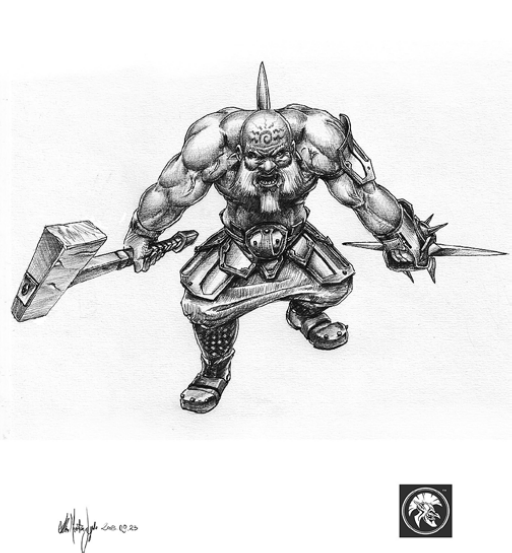
Dwarves don't fuck around.
Ever since then, the dwarves have taken no other god, and only worship their ancestor spirits. When they die, their shades are hunted in the afterlife by furious fragments of the Mother Below, so they gather into large afterlife delves to fight them off forever. The struggle is eternal but they hold on through their courage, their love for each other... and their gold. Dwarves want to die with as much gold as they can gather, because they believe that the gold that is buried with them into death can be brought in spiritual form with them so that their shades can contribute to the defense of their forebearer's afterlife homes. Interestingly, the gold doesn't have to remain with the dead dwarf forever - after a few years, its essence is considered to have "passed on" and it can be safely removed by the dwarf's clan mates. Sometimes the dwarf is so afraid of death that their shade sticks into this world and refuses to let go. In these cases, ancestor priests are called in to quiet the scared spirit, and the tomb-gold is considered to be their rightful payment. Dwarf society is centered around clans, that claim entire delves and parts of the larger underground cities, and as we'll touch on later it is heavily gender segregated. Dwarf adventurers are more often than not driven by the desire for gold, particularly among young men lacking labor prospects. Resolute dwarf women also take axe and warhammer, knowing that they are throwing their chances at good marriage into a pit. And dwarves are always seeking new allies and friends, to better rebuild their ancient delves. Also, they fucking hate slavery.
Elves were a human people whose philosopher-kings taught that gods were simply a greater order of creature, one that mortals could join through the proper rituals and ambitions. They thought that by binding their immortal souls to the substance of their flesh, they could become divine, and in a great ritual that involved all of their people they did in fact do so - but the result wasn't quite what they expected. There are exactly one hundred thousand elf souls in the world; elves don't go into the afterlife, their souls cannot be affected by magic, they're now bound to the earth and thus reincarnate endlessly. Elves are effectively immortal save for violence or disease, and they are invariable beautiful and well formed - any random elf just seems to be a little bit better than a human, and they are found in every human shape and hue possible. Some elves envy the transcendence of afterlife, but their endless reincarnation means that they have an unique perspective on life - all elves know each other, they will know each other again in the future, their grudges can be played out over millenia and no enemy is truly defeated, only delayed. Every death is just a temporary setback. Elves gather into Creeds , like-minded gatherings dedicated to great works of self-improvement and accomplishment. Some are heroic, some are villainous, and some are completely bizarre, hard to understand by other mortals. Those elves who still wish to break the shackles of their recursion are known as Apotheons , and some of them commit ritual suicide to await their people's call in a time of great need. Elves can no longer interbreed with humans, but sometimes a wayward elf soul claims the body of a newborn human: the result is known as a Scion , and the interplay of elf and human soul-stuff gives them very strange powers indeed. Elf adventurers are always part of a high-minded Creed, and they are known through the Isles as notorious crusaders for causes only they truly understand.

Fucking transhuman pointy-eared jerks.
Halflings are said to have been humans that turned away from the gods. Not fighting them as the dwarves or seeking to surpass them as elves, they simply stopped getting involved into divine quarrels and sought peace within themselves. The gods cursed them to be half their size; if they would not fear the gods, they would learn to fear other creatures of this plane. The halflings simply shrugged and moved on. See, halflings are constitutionally incapable of feeling fear or being intimidated: they live quiet, simple lives until tyrants and bullies attempt to push them around, and then said tyrants and bullies are suddenly beset by hordes of tiny ninja, relentless and methodical, willing to die if they can get at their foe.
 Even the rawest halfling militia fighter can be given a spear, told to hold a position and do it until the bitter end, which is why they're sought after as mercenaries - though they're not simply suicidal and can recognize a danger they have to walk away from, in the Isles "a cowardly halfling" is a beast that doesn't exist. Halflings have a philosophy called the
Quiet Way
, which informs all aspects of their life, and teaches them to live out peaceful, bucolic existences. Of course, some of them break from the mold and become "wild", reckless and thieving. Halfling adventurers are usually forced out of their homes through disaster or hardship, and they seek a life of adventure or even wealth to found a village of their own.
Even the rawest halfling militia fighter can be given a spear, told to hold a position and do it until the bitter end, which is why they're sought after as mercenaries - though they're not simply suicidal and can recognize a danger they have to walk away from, in the Isles "a cowardly halfling" is a beast that doesn't exist. Halflings have a philosophy called the
Quiet Way
, which informs all aspects of their life, and teaches them to live out peaceful, bucolic existences. Of course, some of them break from the mold and become "wild", reckless and thieving. Halfling adventurers are usually forced out of their homes through disaster or hardship, and they seek a life of adventure or even wealth to found a village of their own.
As for humans! Eirengarders are tall, blonde, pale folk. They're renowned by a piety that is frankly rare in the Isles, and most of them worship a god called the Maker and follow the teachings of his Iron Prophets . In the old world, the Eirengarder homeland was poor, and as such they became famous mercenaries, hiring themselves to the highest bidder. Even now, an Eirengarder is first a soldier rather than a peasant or fisherman, and most of the surviving mercenary bands are on a permanent contract with Xian. Others hire themselves out to Westmark border lords to fight off goblin or orc raids. Eirengarders are notorious for the different sects in which they worship the Maker - they all have their own little customs and taboos, aside from the greater ones of not eating pork, daily prayer and ritual purification after bloodshed. The martial bent of their culture informs their family life, with men taking in widowed sisters of his wife until they can remarry because turns out mercenary work is really harsh on a husband's survival rates. Eirengarder adventurers can be women shunning marriage for a life of adventure, or men attempting to gather enough gold to start a family of their own. Grim Makerite priests and holy warriors also take to the road on quests of their own, and survivors of shattered mercenary bands can be found with scores of their own to settle.
Ekshanti hail from the old city of Ekshant , trade hub of the old world. Their land was also poor, beset by desert raiders, so they turned outward. Hard-bitten raiders gave way to fat merchants, and soon there was no town without at least one Ekshanti trading family. They're generally dark-skinned, with dark hair and eyes to match, and their life revolves around wealth and prestige - a spouse that brings no dowry or fame to a marriage can be loved, but their opinion in matters usually goes unheeded. Ekshanti adventurers are often young folk from poor families, out to strike it big in the world at large or die trying. Others are the offspring of merchant houses in trouble, trying to find the riches they'll need to save their own, and yet others simply want the freedom of the road rather than a safe, quiet trader's shop.
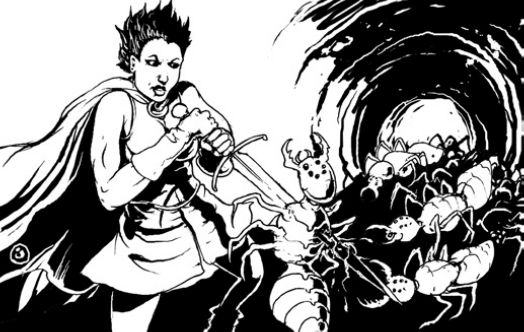
Don't worry, the lady's got this.
Gadaal are a mountain folk, ebon-hued and black-haired. Archmage Lammach himself was a Gadaal, and many of his people listening to his warnings while the Imperials still thought they were little more than ravings. Gadaal worship the night sky and the stars above, and though they were poor in wealth they were rich in knowledge: their astromancers were the finest diviners of the world, superior to Imperial mages, and their accuracy in predicting the future was astounding. So much knowledge was lost in the chaos of their escape, though, and Lammach was not able to train new apprentices properly, but enough remained to keep their astromancy alive in the isles. They keep to traditional ways, living in mountains and hills in large, extended clans, and sometimes feuding with their neighbors. Gadaal adventurers are often bordermen, born in the harsh frontier between civilization and the Shou, and their rangers, mountaineers and seers can be seen all over the isles, looking for fortunes in lost places.
Imperials is the name given to the main ethnicity of the Ninefold Celestial Empire. They tend to be slender, with dark golden skin, almond eyes and straight black hair. The Empire was a magocracy, and the love of learning and knowledge was a highly praised virtue. Even now, parents see the teaching of letters and numbers to their children as great a need as feeding and clothing them, and insulting an Imperial's education is akin to questioning the virtue of their mother. Imperials live in tightly knit families that prize filial obedience above all, and disobeying a parent's order directly is a grave offense against decency. They worship the Nine Immortals , but their reverence is desultory. Imperial adventurers are often poor people that want the wealth to move upwards in society, or mages in training that could not continue paying the fees of Imperial magic schools and had to take to the road to finish their education with hands-on experience.
Kueh were a race of famed warriors and nature-mages, conquered by the Empire after a long struggle. They mostly resemble the Imperials, though their men are slightly taller and both genders cultivate an aristocratic pallor when their station permits. Such was their resistance than the then-Emperor commanded that Kueh be treated gently and that his mandarins married into the greatest Kueh families, and over long centuries of unity cultural barriers vanished and the Kueh joined the Imperial culture. Their samurai served in the Imperial forces, their generals led their legions, their yamabushi cultivated their magics in Imperial academies. Their peasants mostly lived life as they always did in the coasts. However, this saved the peasants - flotillas of little fishing boats fled their lands while their nobles died behind them. One of these survivors was Rai, a yamabushi that rejected natural magic for darker powers, and he quickly came to influence over his surviving compatriots. Lammach never trusted him, and soon he left Xian to build Kitaminato, a center for ambitious young men and women that wished to restore ancient Kueh independence. Then, the ravaging came, Rai sacrificed the souls of his people and became the hellish Shogun. Kueh outside Kitaminato are refugees, sometimes mistrusted by Imperials as Shogunate agents. Such mistrust is quickly forgotten because right-minded Kueh hate the Shogunate with a passion. Kueh adventurers are hard-bitten, with samurai seeking a worthy lord to serve, yamabushi roaming in search of lost lore, and fired up by a bitter loathing of their devil-worshiping brethren.
Skandr are black haired and pale of skin and eye, and the only humans with a city in the Isles before the exile, in the northern island of Aktau . They were famed stoneworkers and masons, which was good because they were also infamous raiders and reavers: punitive attacks against their homelands were rebuffed by impenetrable defenses and walls. It's said that they were slaves to dwarves in old times, though Skandr say there simply was great friendship between them, and though dwarf-mothers say their craft is good "for humans" there is no question that Skandr are the best among men for building. Imperial say that if you leave a Skandr alone in a shore for a night, he'll have a wall of stones built, and if you leave him for a month he'll build a tower. And if you leave him for a year, his cousin will come to knock it down - their matrilineal clans are prone to feuding and vendettas. Their sailors are sought after even now, though ship owners sometimes have causes to concern when Skandr captains forget that they are not pirates. Skandr adventurers might be following their old traditions, young people in search of loot and plunder. There's never any shortage of bandits, Shou raiders or renegade lords to use their blades on, even if the more civilized peoples frown on Skandr going a-viking. Others are drawn by an unquenchable lust for journeying, and though few of these find peace many do deeds worth remembering before they die.
Shou! Wait, the Shou aren't human! But still. As far as anyone knows, the Shou are the native inhabitants of the archipelago, with records of their presence left by the earliest explorers to the Isles. The Shou are divided into four big tribes, that the exiles name using the Eirengarder names for them - orcs , goblins , hobgoblins and bugbears . There were Shou in other lands, too, but it was in the Isles where most of them gathered - and most of the powerful ones. Their witches were a match for any arcanist of the exile fleet and their war chiefs cut swathes through men. It was only their hatred for each other and the cunning of Lammach and the exiles playing the tribes against each other that kept them from simply wiping out the refugees. The Skandr were safe in Aktau, as Shou have always had a great fear of the ocean. The Shou look almost identical to humans, with skin tones going from dark to greenish, and they could even be considered handsome or beautiful by human canons - under all the ritual scarification, branding, filed teeth and general lousy attitude. Humans and Shou are interfertile, though hatred between them leaves little opportunity for peaceful engagement. Shou adventurers (yes!) are almost unknown, but those without the more out there skin colors and that refuse to scar themselves can pass off as human in some places. A known Shou is shunned by humans, though half-breeds are not unknown and in fact are more accepted in human than Shou territories. These unfortunate folk are often forced into a life of wandering to keep the mob from using them as scapegoats for the latest crime. Many seek homes far from their birth place. SPOILERS! You can play a Shou from day one.
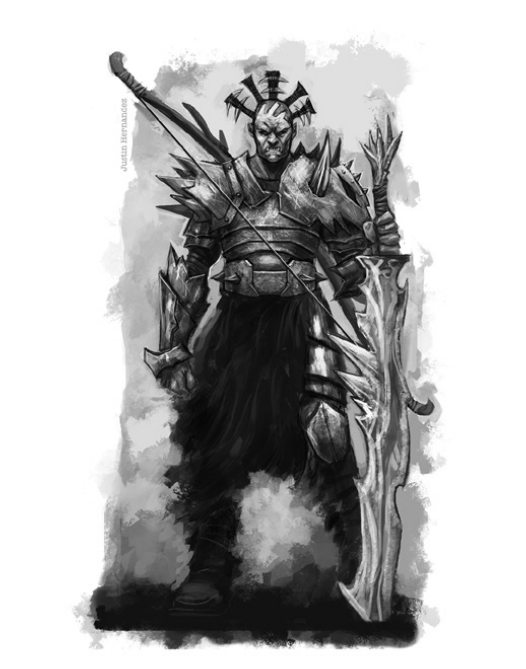
Deep down he's a big softy. Very deep down.
Next: let's see what an OSR guy has to say about gender roles, hm?
Life in Ektau is kind of shitty
Original SA post Red TideLife in Ektau is kind of shitty
Now that we know the people, let's get to know the land. Aside from the larger Ektau and the smaller Aktau in the north, the archipelago is home to a myriad little islands with their own mysteries and perils. Located between two massive oceanic currents, the climate varies wildly from north to south: Aktau's climate is sub-artic, with temperature increasing until the southern reaches of Ektau are pretty much the sweltering tropics. Central and northern Ektau enjoy a warm, temperate climate with four distinct seasons, and are thus better suited to agriculture. Traveling around Ektau is hard going: roads are primitive, perils are many. The sea is the main form of travel between the great cities, being faster and safer than ground journeying, though there's still pirates and freak storms sending ships screaming into the Tide a hundred miles from shore to consider. The central waters of the archipelago are highly dangerous, so most travel between Ektau and Aktau tries to skirt the borders of the archipelago, hoping that the Tide won't claim those ships. We even get a classic wilderness random encounter table here: as many of those encounters could eat a low-level party for dinner, the GM is encouraged to give PCs hints by showing ruined homesteads, claw marks and other evidence to lead them another way. If they continue though, that's the sandbox for you.
We later get some interesting points all over the archipelago, along with maps. Most of the central zone is too dangerous to explore thoroughly, but still there are some places that are familiar - or at least, agreed upon. The Angrimmr mountains in Aktau are a harsh, jagged spine home to dwarves, who are obliged to dig carefully - not all of the frozen peaks are devoid of life. Coldthrone is a small frozen island said to be the home of a powerful, malevolent ice wizard. The Godbarrows is the mountain chain that splits Ektau in half, and the Shou claim that it was formed from the flesh of their god Shakun when he sacrificed himself for his people. It is rich in veins of precious godbone. The Isle of White Teeth is surrounded by sharp reefs, and its isolation makes it a favorite of Xianese outlaws and other undesirables. It is said that a group of renegade Kueh plot the fall of the Shogunate deep inside the island. Keelhaven is an island where good pines for shipbuilding timber grow, but it is said by Skandr sailors that there are "green devils" that harvest and cut down men as men do to trees. North Neck is a small country ruled by the Shogunate, home to picturesque villages and haunted ruins from the Ravaging. Care must be taken with Shogunate patrols. Scylfing is a mountainous island west of Aktau that according to Skandr records used to be much warmer in old times. Those records also said that the Skandr found Shou-built cities there but no one seriously believes the Shou had a city-building civilization. Sheshan Island is an outpost of civilization west of Ektau, safe in the knowledge that Shou dread the water and won't go after them. It is nominally ruled by the Mandarin of Xian but no one in Sheshan takes mainland authority seriously. And so on: these are just a few places of ADVENTURE in the islands.
Let's talk about the domains of Ektau!
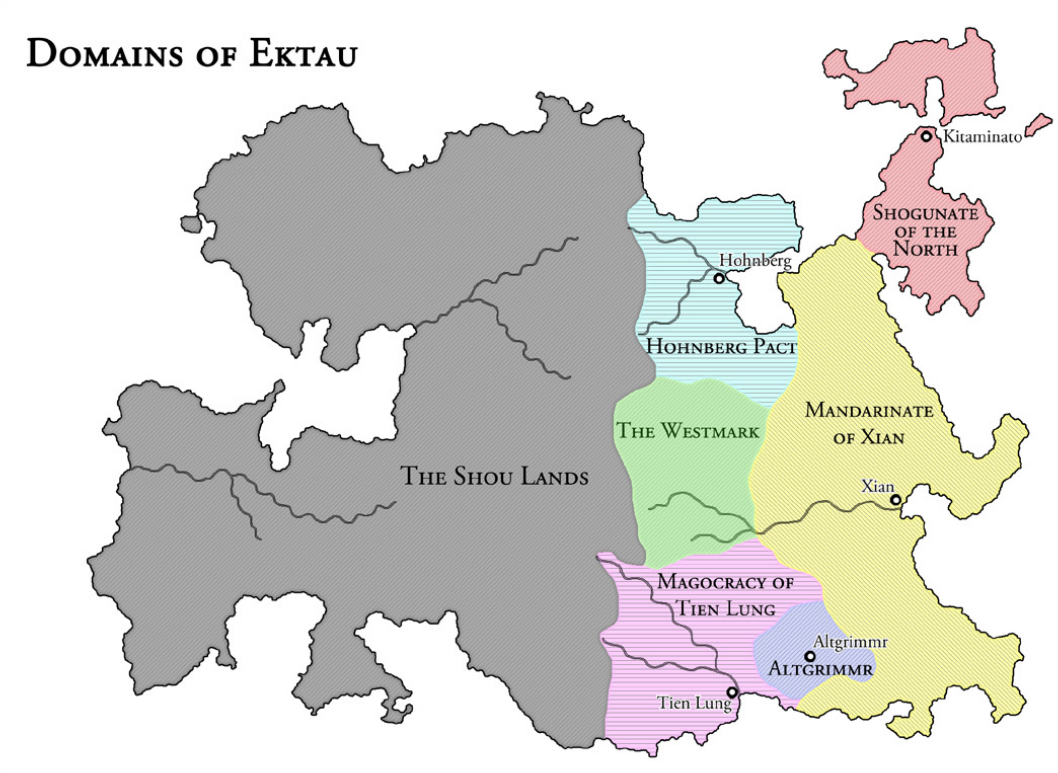
Map!
Altgrimmr is home to 23,000 people, 2,500 of them in Deep Algrimmr, under the rule of the Underking. They've been here since before the humans, though fending off Shou raiders and others made for a harsh living. Ironically the end of the world let them expand as the influx of exiles drove the Shou further west, but even now no more than a fifth of the ancient Altgrimmr delves have been reclaimed, much less reoccupied. The Underking loathes sending his people to fight the wars of men, but the dwarves recognize the threat of Tien Lung and are therefore allied with Xian (though they dislike Xianese judicial slavery) as well as Hohnberg (though they dislike their zealous piety). The dwarves are divided in clans, and marriage is customarily celebrated between clans, so most delves are joined in a complex web of family ties. Social roles are sharply divided between men and women: for instance, while the Underking is always a man, the leaders of the crafting guilds are always women. Leaders of the ancestor cults may belong to either gender. And speaking of ancestors, sometimes dwarves get sick of shit and actually seek to worship the Mother Below once again; these are known as Repenters , commanded by fragments of the wicked goddess to undertake acts of torture both self inflicted and inflicted on those dwarves that won't recognize their one true mistress. Dwarf law is harsh, without many of the human expectations of liberty or carelessness. Dwarves have to do what they have to do to keep their delves alive, and as such their life is highly regimented. While executions are forbidden because no dwarf may kill another dwarf (exile is their worst punishment), sometimes dwarves just snap under the demands of life, and the tight confines and disputes of the delve erupt into bloodshed. Altgrimmr trades steel and iron for human crops, but those holdings that don't or can't trade with humans have to make do with meat beetles and varied fungi for food and drink. They dress in metal and fungus-leather, with forge workers using little more than a work harness and those working in the surface thickly bundled up against the chill.
The Hohnberg Pact is home to 93,000 people, 8,000 of them live in Hohnberg itself. The inhabitants of the Pact are mainly of Eirengarder stock. The land is rich in resources, with gold and silver mines and coastal grasslands, but the Pact is poorer than it should be because it is so isolated: trade is hard due to the rough terrain between them and other human polities, and sea captains have to choose between braving hostile Shogunate coasts or taking a long, dangerous trip west to circumnavigate Ektau. As such, more than one young pikeman has to leave the city to seek fortune. Eirengarder military tradition permeates Hohnberger society, with status pinned to military accomplishment or wealth. Those who own real estate are known as Landsers , and can vote on questions put to them by their leaders. Almost all Hohnbergers are also members of a Company , an organization that crosses their society vertically and where people may socialize with each other. They take care of widows and orphan children, among other roles, and are used as militia units if the city is in danger. Hohnbergers are also associated with a particular Makerite church, as faith in Hohnberg is a lot more serious than in other places of the Isles. Aside from common taboos, each church interprets the Law and the writings of the Iron Prophets differently. Many Hohnbergers make their fortune as mercenaries, with some of their bands having a history going beyond the end of the world. While many are heroic, some mercenary bands are little more than bandits.
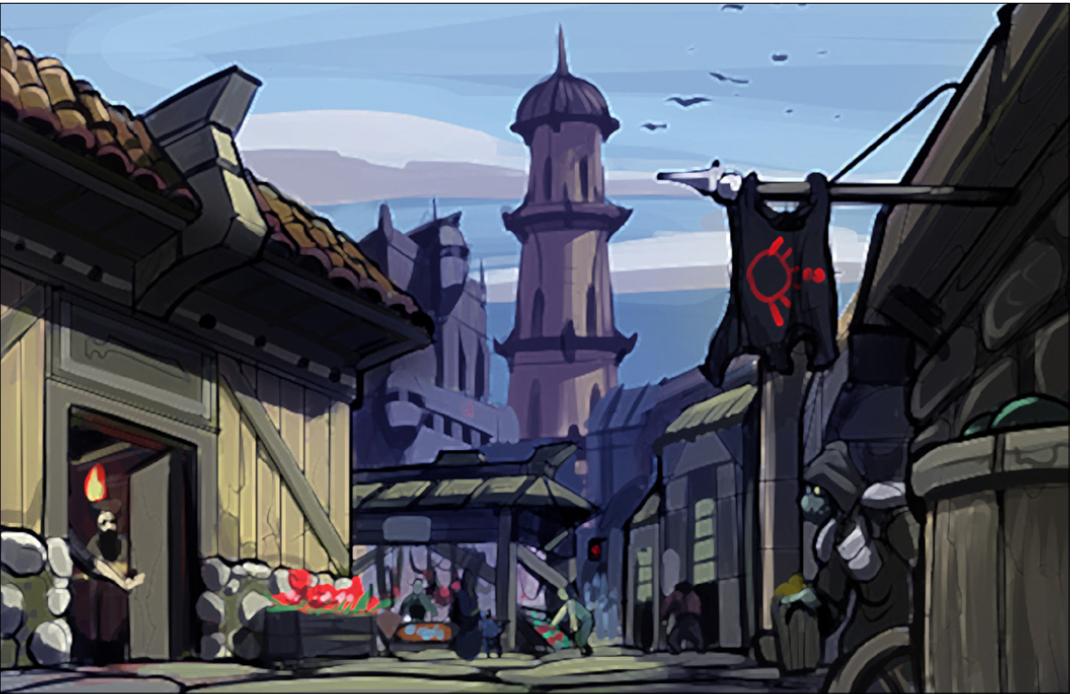
Color art!
The city is ruled by the Thusundi, chosen by the Landsers upon the death of the former lord. Beneath the Thusundi are the Obersts , leaders of the Companies, who employ other lesser Landsers in various city posts. The High Priest of the House of the Maker , the largest church in Hohnberg, also has a say even though he doesn't have an official posts. His word against someone makes it very unlikely that that person will hold office. Religious governance is left to the churches themselves, with government steering away from doctrine disputes. The Pact at large is called like that because its myriad villages and towns engage into a pact of protection with Hohnberg: the city provides security in exchange for tribute. Those who stop paying are not harmed, but neither are they protected the next time some bandit dickhead comes by to loot the place. Hohnberg law is generally the same as Xian, with the notable exception of slavery - restriction of freedom is loathsome to the Hohnbergers and any slave in Pact lands is automatically freed. However, this makes their justice unusually harsh, as any crime worth prison or servitude in other territories is punished by death. Military justice is even harder, as the accused don't even get a trial by jury, they just get executed or beaten on the spot. While the Makerite churches are the most important, veneration of other gods is not forbidden unless it is the Hell Kings, in which case the offender will at least be beaten harshly if not executed for being a hell priest. Hohnbergers dress warmly as the climate is cooler in their lands, with mercenaries favoring bright colors easily visible in warfare. They love wheat and barley beers, but pork is forbidden to be sold in the city and in most Pact polities due to Makerite beliefs.
The Magocracy of Tien Lung has 128,000 people, 11,000 of which live in Tien Lung itself. It is home to the greatest school of arcane knowledge in the Isles, but it asks a terrible price of its followers. After the Ravaging, the sorcerers of Tien Lung became drunk with power, no longer sacrificing people out of dire necessity but simply to explore the darkest reaches of their magical ability. This, along with their great rice paddies and drug plantations, means that the city is rife with chattel slavery, and most crimes are quickly punished by the accused becoming a slave. Tien Lung's culture would be easily recognizable to a Xianese, but there's always the subtle sense of corruption and power-lust in all dealings. Tien Lungan society is divided between the Learned (those who can cast magic, divine or arcane, even a single spell) and everyone else. Laws favor the Learned on all things, and they can kill, steal and mistreat commoners with impunity. However, the law recognizes self-defense as a justification for killing, and it will side with a commoner that kills a Learned in self-defense - after all, if a commoner can kill you then maybe you're not as Learned as you thought. Disputes between the Learned themselves are outside justice's remit, and spellcasters can duel and cast shit on each other to their heart's content, though in practice the Academy keeps a number of legbreakers and enforcers to bring unrestrained wizards to heel. Tien Lung is the hottest of the cities, so commoners wear as little as modesty permits - or less, depending on their role. The Learned dress in ornate, complicated robes and tunics and cool themselves with magic as a show of power. Members of the Academy dress in the colors and insignia of their faction, and outsiders run the risk of offending Academy members over obscure faux-pas. The Tien Lungans eat mostly rice and fish, supplemented by jungle fruits and the produce of slave plantations. Spices and drugs are used liberally, and Tien Lungan poisoners are infamous for being able to slip poisons past a taster.
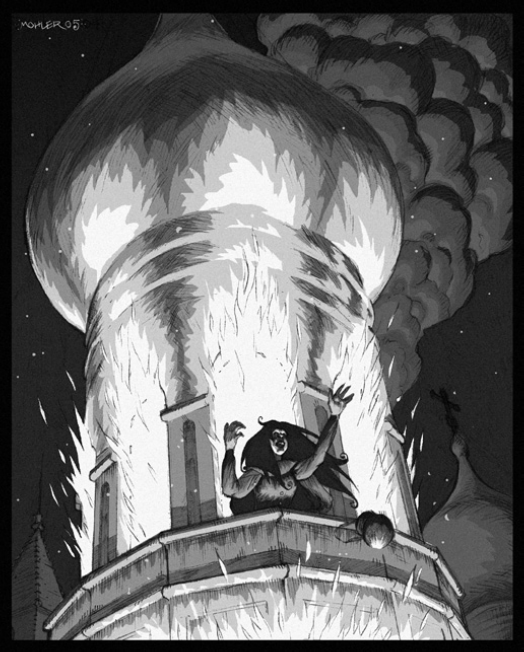
Only then did she realize that using a human sacrifice to power the fire in her stove wasn't a good idea in the slightest.
The Mandarinate of Xian is the largest polity, with a population of 162,000 and 14,000 people living in Xian itself. It is led by the Mandarin, the regent of the Emperor of the Ninefold Celestial Empire in Ektau, though no one believes there's any Emperor or Empire in existence these days. The current Mandarin, Sei-Wen MacLammach, belongs to a unbroken line going all the way back to Lammach himself and his word is law, though currently the Mandarin issues few orders, focusing himself on studying records of his glorious ancestor and making strange plans to retrieve long-lost magic lore. He wed a Tien Lungan princess some years ago, but has not produced any heir. It is an open secret that he prefers the strapping young men guarding his seraglio than the girls of his harem
 and while that doesn't bother the people much because aristocrats gonna aristocrat, the fact remains that officials and noble families are uneasy without a defined heir. Xianese society is divided into commoners,
daifu
and
zhuhou
. Justice is held between commoners mostly fairly, but trying to sue someone of higher station is a lost cause unless the crime is too great or the magistrate can be moved to pity. Daifus are the "scholarly" class, drawn from zhuhou descendants or commoners ascended through merit and service. They may not necessarily have anything to do with education, earning their place through military merit or other ways. Daifu status only extends to the children of the daifu - their grandchildren are commoners unless they too ascend to the class. Zhuhou are the "princely ones", the real rulers of the city. Commoners give them a wide berth or are otherwise very obsequious with them because they can pretty much do whatever to them. Only one person can be elevated to zhuhou - their spouses, parents and immediate relatives are treated as daifus. The
Junzi
are the overseers immediate below the Mandarin, of zhuhou stock. They rule the ministries of the city. Beneath them are the
Hundred Magistrates
that hear cases and resolve disputes all over Xian and its towns and villages. Xianese law is derived from the old Empire code, with people receiving more consideration in trials depending on their station. Only the most grievous of crimes against a commoner can leave a zhuhou in the stock, for instance. Punishment involves beatings, execution and forced servitude - long-term imprisonment is rare. Magic is an acknowledge part of law, with magical testimony admissible evidence though most will reject using it, knowing how easy it is to fake it. Magic crimes are hard to prove, but severely punished when it happens. Necromancy is not technically forbidden, but messing with someone's remains is such a grievous offense that even the humblest peasant family can expect swift justice, and no magistrate will hesitate to punish a necromancer that defiles a body so even if they are a zhuhou. Almost all religions are admissible in Xian, with the exception of Hell Kings and Tide worship. The Xianese also dress lightly, with saris and sarongs, but wearing jade accessories is restricted to daifu and zhuhou classes. Only zhuhou may wear blue-buttoned caps. Xianese cuisine favors rice and seafood, and even the poorest peasant can expect a full bowl of rice porridge at dinner. The wealthiest dine lavishly, and "jewelers" pick between leftovers of princely dinners to fashion meals to sell to people of lesser station.
and while that doesn't bother the people much because aristocrats gonna aristocrat, the fact remains that officials and noble families are uneasy without a defined heir. Xianese society is divided into commoners,
daifu
and
zhuhou
. Justice is held between commoners mostly fairly, but trying to sue someone of higher station is a lost cause unless the crime is too great or the magistrate can be moved to pity. Daifus are the "scholarly" class, drawn from zhuhou descendants or commoners ascended through merit and service. They may not necessarily have anything to do with education, earning their place through military merit or other ways. Daifu status only extends to the children of the daifu - their grandchildren are commoners unless they too ascend to the class. Zhuhou are the "princely ones", the real rulers of the city. Commoners give them a wide berth or are otherwise very obsequious with them because they can pretty much do whatever to them. Only one person can be elevated to zhuhou - their spouses, parents and immediate relatives are treated as daifus. The
Junzi
are the overseers immediate below the Mandarin, of zhuhou stock. They rule the ministries of the city. Beneath them are the
Hundred Magistrates
that hear cases and resolve disputes all over Xian and its towns and villages. Xianese law is derived from the old Empire code, with people receiving more consideration in trials depending on their station. Only the most grievous of crimes against a commoner can leave a zhuhou in the stock, for instance. Punishment involves beatings, execution and forced servitude - long-term imprisonment is rare. Magic is an acknowledge part of law, with magical testimony admissible evidence though most will reject using it, knowing how easy it is to fake it. Magic crimes are hard to prove, but severely punished when it happens. Necromancy is not technically forbidden, but messing with someone's remains is such a grievous offense that even the humblest peasant family can expect swift justice, and no magistrate will hesitate to punish a necromancer that defiles a body so even if they are a zhuhou. Almost all religions are admissible in Xian, with the exception of Hell Kings and Tide worship. The Xianese also dress lightly, with saris and sarongs, but wearing jade accessories is restricted to daifu and zhuhou classes. Only zhuhou may wear blue-buttoned caps. Xianese cuisine favors rice and seafood, and even the poorest peasant can expect a full bowl of rice porridge at dinner. The wealthiest dine lavishly, and "jewelers" pick between leftovers of princely dinners to fashion meals to sell to people of lesser station.
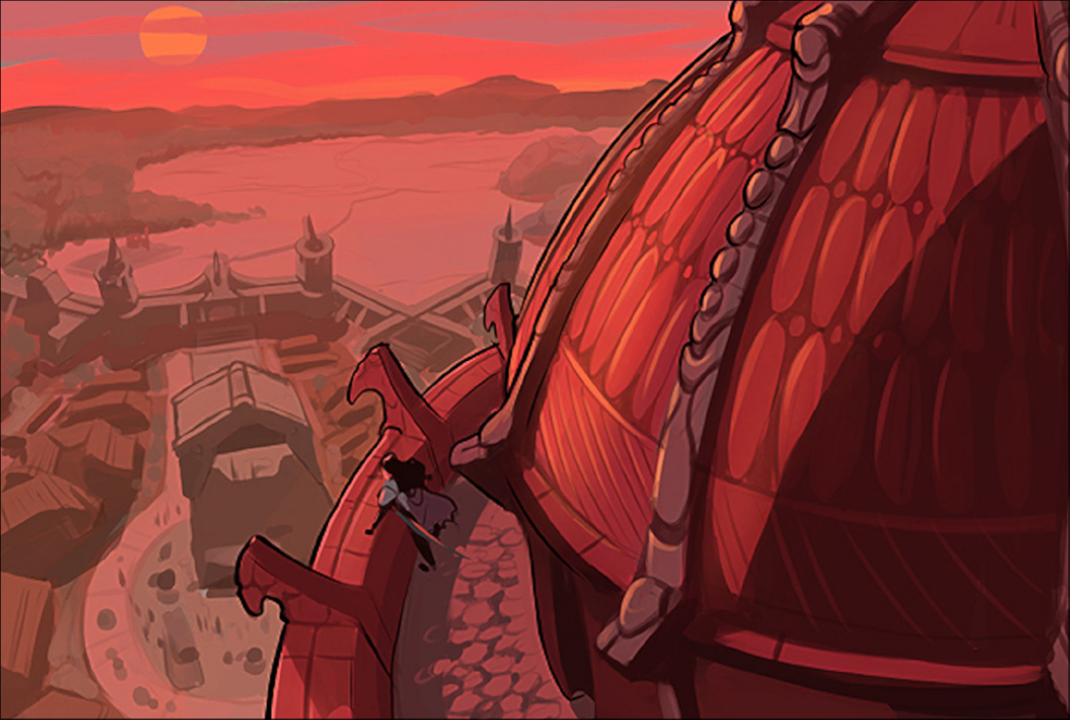
More color art!
The Shogunate of the North has a population of 116,000, 10,000 of which live in Kitaminato. It is prosperous and wealthy, but its people live in haunting fear of their ultimate fate after they die, for those blessings are literally infernal. At present, it is engaged in a low level war with Xian, with "bandits" and "pirates" preying on Xianese assets, while Tien Lung bides its time and waits for a chance to press claims on Xianese territory. The Shogunate mostly comprises ethnic Kueh, and society reflects that with clans of shared descent. Merchants are at the lowest position of society, unable to own land, with farmers slightly above them. The samurai families and the daimyos that rule them are atop the societal pyramid. Adventurers and other outsiders are not considered by Shogunate law and can be harmed or killed at the leisure of anyone. Oddly for such a horrible place, there is justice and criminals are dealt with - the Hell Kings reason that those practitioners of evil that are not caught do better, and hell priests quietly celebrate the deeds of evildoers even as they order their execution for their crimes. Shogunate society is thus a web of deceit and murder under a facade of elegance and grace. Not all citizens follow the path to damnation so willingly, though - some try to strike back at the Shogunate, or worship better gods and are generally nice people to defy the Hell Kings. The Shogunate was ultimately built to protect Kueh culture and restore them to their imagined glorious past, and Rai's wish was made with this in mind, but ironically uncorrupted Kueh culture only exists outside of Kitaminato's influence. The locals don't like being reminded of this.
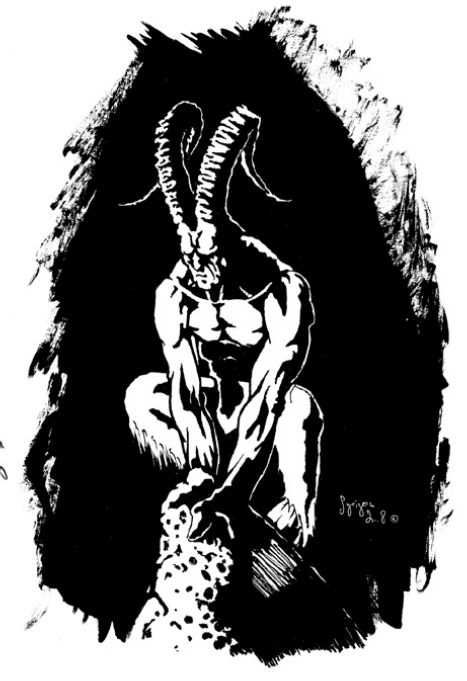
Demon corrupter finds no pleasure in his job.
Shogunate lands are rich due to hellish blessings, and even the poorest, most beaten down peasant goes to sleep with a full belly most of the time, while a village samurai eats like a Xianese daifu. Cuisine emphasizes gluttony and avarice, and Shogunate nobles like to play at snatching morsels of food from each other's play, or forcing each other to eat ashes and filth as punishment. Clothing focuses on silk kimonos, tunics and breech clothes depending on station, many times adorned with blasphemous characters. Even beauty is corrupted to the service of the Hell Kings.
The Shou Lands may have at least half a million people in the western half of Ektau. Never uniting again after the Ravaging, they still send war parties and raiders down from the Godbarrows to strike at the hated invaders, but they are wracked by disunity and backstabbing. The three major breeds of shou are orcs, goblins and bugbears: hobgoblins are a particularly large and smart version of goblins that are sometimes born from their tribes. In theory, a Shou tribe is ruled by a chieftain that got there through battle prowess and cunning - in practice, witch priestesses hold much of the power in the shadows, propping up a series of dashing, brave and ultimately disposable chieftains as figureheads. Shou men hunt, war and raid, while women tend to domestic duties, but farming and other civilized practices are "slave work" and not done by proper minded Shou. They put great stock in purity of blood and believe that someday Shakun will return to take the best of his children with him, which is a great reason for their lack of ability to stick together against common foes. Deep in their lands, there's evidence that perhaps they were not always the savage tribals of the modern day - great city ruins, that could be waved away as the work of some other human empire if the writing in some of the stones didn't match Shou clan markings. Shou have little in the way of law, recognizing only custom and the rule of the strongest. Almost all of them hate humans greatly, and half-breeds are exposed at birth. Some more cunning tribes trade with humans, which puts both Shou and human traders at risk of lynching by their fellow race members. They favor barbaric tattoos and piercings, and eat wild game, fruits and whatever they can plunder from humans. A few settled tribes even have slaves to tend to fields for them, but those are rarely found in the frontier.
Finally, the Westmark holds around 20,000 souls. Once a thriving province of the Mandarinate, after the Ravaging it was left a scarred, harsh frontier land. In the past thirty years, population pressure has driven more colonists to the Westmark in search of land and fortune. The soil is rich and there are many ruins with wealth unplundered yet, so bands of adventurers gather every year to roam the Westmark. Far fewer ever return. The bordermen are a disparate lot, with no universally recognized ruler or united territory larger than a single settlement or market town. The surrounding polities would like to change this, however, and they all have military outposts vying to get more settlements under the rule of their masters. There's no real law in the Westmark beyond the point of a spear, though. They dress in the manner of their home cultures, and they eat well thanks to the Westmark's good land and rich game and natural produce. At least, what they can gather, with all the Shou and bandits around.
And now, let's talk about institutions in the isles. Slavery is commonplace, practiced to different degrees in Xian, Tien Lung and the Shogunate. In Xian it is a punishment for criminals and people who fail to pay taxes. Slaves are owned by the city and not treated gently, but they do have some rights and abuse against slaves could end with the abuser ending up in the same chain gang as the victim. Most are indistinguishable from other commoners, though they are branded with tattoos to keep them from blending in easily with free people. In Tien Lung, people are bought and sold like cattle, and almost anyone runs the risk of being pressganged by roving gangs. The least fortunate of these become guinea pigs for the experiments of the Learned. Shogunate slaves are the least fortunate of them all, but life is so harsh anyway that it is said that the Shogunate doesn't practice slavery so much as fail to practice freedom. The Makerites of Hohnberg refuse to have anything to do with slavery. Elf attitudes to slavery vary depending on their Creed, but most of them despise the practice. Halflings have a hard time even understanding the idea of laboring solely for the benefit of someone else. And of course, dwarven hatred of slavery runs marrow deep, and only grudgingly does the Underking accept that Xianese slavery is a punishment for criminals. Even the meekest dwarf will choose suicide rather than becoming someone else's property, and both dwarves and Makerites are the strongest backers of abolitionist circles all over the Isles.
Gender roles! Ah, you were waiting for this. There's a consistent sense of gender roles among humans no matter their polity or culture. Theoretically, women are subservient to men, expected to be mothers and homemakers as well as helping with simple home crafts to support a household. Men are expected to work outside the home and to serve in military forces and martial branches of society. In the Imperial tradition, unmarried women are expected to remain at home under the custody of their father or an older male relative until they marry. But such customs simply don't hold in modern Xian or anywhere else - the laws are technically there, but only enforced against political rivals and even then the enforcement only lasts as long as the relevant magistrate can be bribed. Simply put, life in the Isles is too harsh to hobble half your populace unnecessarily, so women can by and large do the same things as men and enter any possible career. Yes, there's some places where one gender or the other will have an easier time fitting in, but once skill is proven the Xianese care about what you can do rather than what your bits are. In the Mandarinate, the famous Admiral Ten Fires Carp is a woman, and most of the professional clade of the city (lawyers, architects and such) is actually female. Most other human cultures follow similar lines, with their own quirks - Eirengarder women that take up arms are traditionally exempt from traditional "womanly" duties like cooking, so telling an Eirengarder merc that it's her turn to make grub for the party is cruisin' for a bruisin'. Elves are even more egalitarian than humans, given their reincarnation deal, and halflings tend to stick to traditional roles but only out of habit and inertia, and don't see it as wrong if a lady becomes sheriff or a guy stays at home.
Dwarves are markedly different in this regard from all others. Only men fight and build, and women have pretty much no chance of taking up these roles without societal shunning. But it cuts both ways, too: only women craft and trade, and men who pretend to those roles will find a similar fate as their female opposites. In fact, there are (don't laugh) men's rights organizations in dwarf delves, but rather that posting to the Undernet about how they're incels and the womyn rule everything and it's so harsh, man , what they want is to get men access to female positions because if a young boy wants to be the very best blacksmith like his mother was, that's his own damn business. While most right-minded dwarves scoff at the idea of using "mannish" goods, these organizations have made inroads in some delves. Unfortunately, their female counterparts have not been as successful.
Finally, Religion! The people of the Isles are generally lacking in piety, what with the Tide eating up the world and all. The cults that remain tend to be simple faiths with little concern over contradictions, so you might end up with two priests of the same god holding very different beliefs. It doesn't help that communications with the divine are garbled - while Commune spells work, the gods seem very reluctant to speaking of the Tide or offering any useful information to their followers, so not even their clergy agree on how to best serve them. The traditional gods of the Empire, the Nine Immortals, are popular - but devotions don't go much further than quick prayers for luck, blessings at birth and proper burial rites to keep the dead from being eaten by the Hell Kings. The Nine Immortals are served by a legion of tulpas and celestial devils: the tulpas represent their most positive aspects, while the devils represent their most negative ones. For instance, a devil of Fa Chia, Immortal of law and integrity, scourges lawbreakers and hypocrites, while his tulpa enlightens judges and reveals the right paths. The Skandr were never a terribly pious folk, but they still pay homage to three major gods: Sifr the lord of the waves, Anghad mistress of the mountains, and Hjal the red-handed god of battle. Skandr faith tends to be very practical, with worshippers offering so many barrels of beer or other goods upon successful completion of an enterprise, and prayers to whatever gods are relevant to the matter at hand. The Gadaal worshipped impersonal conceptions of destiny and free will, in a complex way that was almost completely lost in the exodus; all that is left now is simple folk creed. The Eirengarders hold to their monotheistic faith in the Maker, and they actually claim that he made the entire world - a laughably arrogant idea to others, but there's no denying that Makerite warpriests were responsible for some of the most impressive battlefield miracles of the pre-Tide era. Ekshanti are polytheistic, and cheerfully so: in the old times, they collected gods like so many shinies, and clans boasted of the myriad gods they served and the blessings they received from them. Nowadays small Ekshanti family shrines are all that remains from entire old world pantheons. The Kueh held to Imperial beliefs mostly, with ancient traditions of nature worship added to the mix. The Hell Kings teach that eventually both this world and the afterlife will fall to the forces of Hell, so why not make it easier on you? They're generous with clerical power and material blessings, but they demand obedience. Ultimately, though, even the most fervent worshipper of the Hell King will be thrown into the hellfires along with everyone else, but the demons don't feel the need to share that detail with their followers. And every year, new strange faiths and messiahs pop up in the Isles, to the general lack of care of the population: what use was the new god when the Tide came?
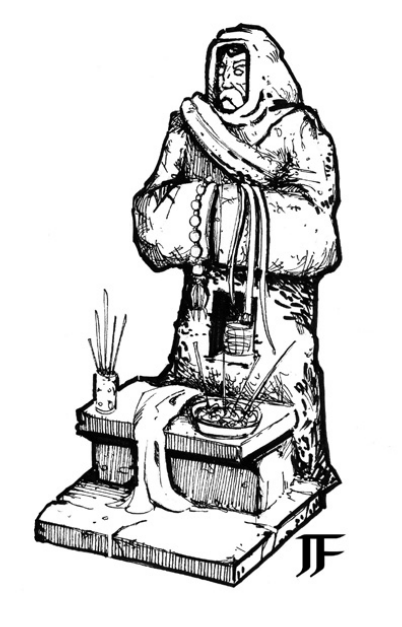
Have you heard the good word of Xenu, my friend?
Next: okay, okay, but what about the rules?
You are our hero, you are our hero
Original SA post Red TideYou are our hero, you are our hero
So how about them adventurers , huh? The Isles are fraught with peril: every borderman knows that at some point he will have to fight for his life, and there's danger even in the civilized cities. Most of humanity's defenders are simply guards and watchmen, but some people just aren't cut out for that kind of still life - they want to go outside, explore the world, take the fight to the monsters and strike it big. Adventurers are a fixture of the Sunset Isles and there are some expectations regarding them. They serve as civilization's early warning network, bringing back news of dangers about to befall towns and villages. They are cheap, disposable manpower for tasks that important people want done without expending trustworthy servants in them. They are a release valve for the most ambitious young men and women, going outside rather than making up trouble at home. And the veterans of these adventures often become the driving forces of further exploration and colonization attempts, using their expertise to protect settlers. Many of them eventually become village chiefs and outpost captains. Up until then, though, adventurers are seen by civilized folk as a rough, untrustworthy lot, reliable when it's swords time but better off sent elsewhere when the danger is gone.
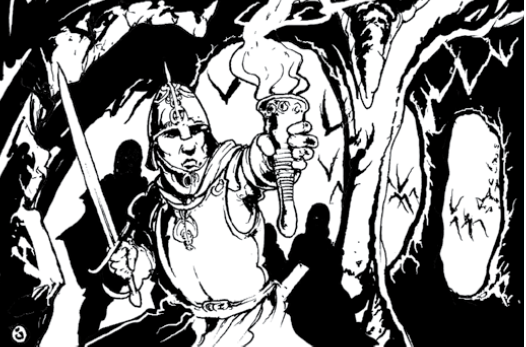
Sure you want to hold your torch like that?
Clerics are rare in the Isles. For most people, a priest is just that - a man or woman versed in the lore and rituals of religion. People with a provable connection to the divine often rise to preeminence in the temples, but also great responsibilities are placed on them. Only humans and Shou worship gods in a recognizable way, though, and Shou clergy are most often witches. The elves prefer their Creeds, halflings stick to the Quiet Way, and dwarves bow to no god. They have no rules changes from the core Labyrinth Lord book.
Dwarves on adventure have often been driven from their homes by tragedy, societal pressure, lack of conformism and simple desire for gold. They always leave with a purpose, though, and they're not wont to let anything stand in their way. There are also ancestor priests, who don't have clerical powers but are still knowledgeable with the details of burial, funerary rites and appeasement of dwarf spirits. Since the tomb-gold is considered to pass on to the afterlife, they have little compunction about reclaiming it, but they are very sensitive with strangers looting the tombs of their ancestors. Dwarves also have no changes from the corebook.
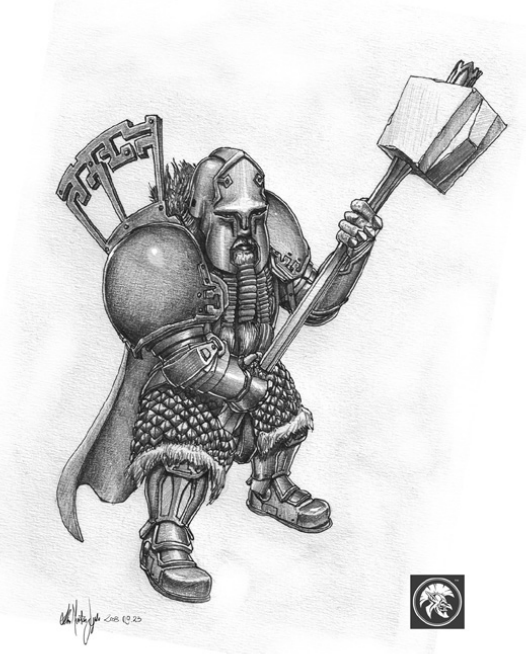
They look badass as fuck, though

Elves are by far the rarest of the demihuman classes. Those who venture out in the world are almost always a questing lot, ambitious and driven to achieve great goals. After all, death is temporary. Most use the standard rules, but Scions behave differently. They can't cast spells as regular elves do, but they have access to an unique type of powers called wyrds . These wyrds are reality warping manifestations of a Scion's strange soul, and as their power grows they become more and more adept at shaping and shattering the laws of nature around them. Wyrds are divided in levels as spells, with Scions being able to master a number of them depending on their level. They don't need a teacher or materials to do so, but once a wyrd is learned it cannot be unlearned. Each wyrd can be used a different number of times per day, and they can be refreshed by eight hours of sleep. Scions can't use magic scrolls or other magic user items, but they are considered elves and have all other elven abilities.
Fighters can represent anything from Kueh samurai to Ekshanti knife-fighters to simple slum brawlers. Skilled fighters are highly esteemed in the isles, and civilization has not grown so decadent that they can't appreciate a strong arm when it counts. A fighter of skill and resolve can often find fortune as a landowner or border noble, assuming they survive. Fighters reroll any hit dice that come up with less than 4: the Isles weed out the weak.
Halflings are almost always driven away from their villages by necessity. In times of privation, the younger, more promising inhabitants of a village are sent to make their way into the world. Many of them die forgotten and alone, but some often accumulate enough fame and wealth to start their own village, or lose the taste for the Quiet Way entirely. Halflings use the corebook rules, but they are completely immune to mundane sources of fear and gain a +4 bonus to saving throws made against magical fear effects.
Magic users cover everything from wicked Tide cultists to Imperial academy graduates. They are rare, but not unknown in the Isles, since many magical traditions made the way across the sea. Petty magic is almost unknown, however, in stark contrast to the myriad small wonders of the Ninefold Celestial Empire. Most cities have at least one academy for gifted students, though, and even the poorest won't be begrudged an education if they show aptitude - but the government will expect a return on their investment. Magic users use the normal rules for their class, and many local academies have access to the new spells included in the supplement.
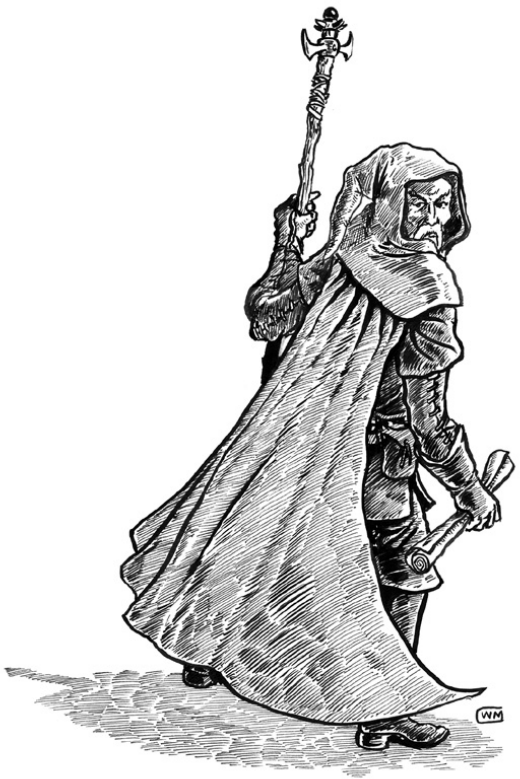
Dig the Fu Manchu 'stache.
Shou characters will very rarely be full-blooded; half-breeds are much more likely, finding it easier to conceal their origins. These outcasts find the adventuring life the best path to wealth, if not societal acceptance. Shou can take any class that humans can, including fighter, thief, magic-user and cleric, though the latter two have no tradition in the tribes, replaced by witches. All Shou and individuals of at least half-Shou blood have an instinctive hatred of the Tide, translating into a +4 to hit against Tidespawn and cultists and a +4 on saving throws made against magic employed by these. Furthermore, any Tide effect that could cause permanent change on a Shou lasts no more than 1d4 minutes - they're not immune to Tide corruption, but it never sticks for long.
Shou witches are one of the book's new classes. Despite the name, men can become witches too if they show aptitude, but the taboo is such that they are considered ritually and socially female once they are initiated into the secrets. They attack and save as clerics, have a d6 HD, can wear leather or studded leather armor, use daggers, slings, quarterstaves, bows and spears, and must be at least half-Shou. Witch secrets are jealously guarded, and only a made witch can initiate a hopeful into the class. Such teaching cannot be coerced by others, neither by mundane not by magic means. Their spell list is similar to that of Clerics, with some special witch-only spells, but they can't learn new spells from scrolls or teachers. Furthermore, any scrolls they prepare can only be used by other witches. So long as a witch has at least one spell prepared and uncast, she can use witchfire , an arcane ranged attack. This attack does not spend any spells unused, it only needs them to be present in the witch's head. Witchfire is treated like a ranged weapon with a range increment of 50', with a hit roll modified by Dexterity and dealing 1d6 damage (2d6 at level 7). It also can never harm someone the witch doesn't want to, so it's safe to use when her allies are engaged in melee. They are treated as clerics for purposes of class-based effects and rules, and can use clerical scrolls even if the spells are not on their list.
Thieves have no rules changes from the core, but Red Tide treats them in an interesting way. While thief skills are commonplace from one point of view, thieves can push them into the almost supernatural: yes, anyone can climb a wall with rope and hook or sneak past a guard, but only a capital-T Thief gets to scale a sheer wall of glass, or disappear into a sliver of shadow no wider than their palm. Sometimes this may be justified by tong assassin training or ninjutsu, or simply because the thief is uncannily good - whatever the case, it seems to be an uniquely human ability, as not even the stealthiest elf or halfling can match the prowess of a veteran human thief. Isle justice is harsh on criminals, but thieves can be respected as long as they limit their larceny to ruins and enemies of the civilized world.
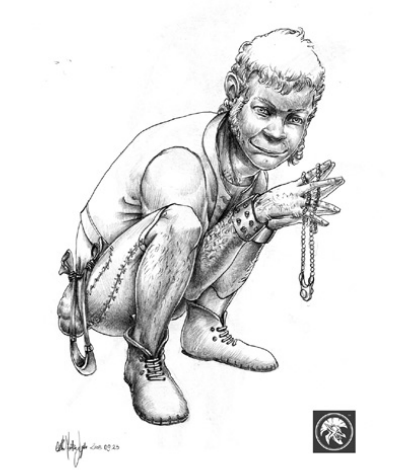
You just know this sneaky git already knows how to fleece you.
Vowed are unarmed martial artists of great prowess. Their skills came from secret disciplines and austerities maintained by the different faiths, aiming to produce individuals of physical and spiritual excellence. But the chaos of the Tide and knowledge lost has turned many Vowed schools into simple martial arts disciplines, without the spiritual component. Still, a certain measure of connection to the divine is needed to master the powers of the Vowed, so Godless races cannot become one. Shou can be Vowed if any master that will teach them can be found. Vowed have a d6 hit die, attack as fighters and save as clerics. They wear no armor whatsoever, not even shields; in return, they can deal superior damage bare-handed and have an innate AC bonus that improves with DEX. These bonuses only go up with time and levels. They also have mastery of some weapons, like the dagger, quarterstaff and short sword for when bare-handed fighting isn't the most ideal. Unarmed attacks can be performed with at least one limb free, and Vowed don't take damage from hitting dangerous enemies like fire elementals or iron golems. Their fists are considered to be made of silver for purposes of harming magical creatures at third level; at seventh, they are considered to have whatever bonus necessary.
At first level, they pick a style from three choices: Iron Tempest focuses on raw damage and destructive potential, Water Hand deals with subtle redirection and non-lethal resolution, and Ninjutsu is about being a sneaky git. They gain their style's novice ability at first level, their student ability at fourth, and they master the style at eighth level; they can start learning a second style at ninth. They can also learn unique Arts , some of which include running across water (Novice Art), becoming immune to mundane and magical diseases (Student Art) or even treat any attack as a natural 20 once a day (Master Art). The Vowed is an interesting take on the monk, but personally I feel the styles are kind of unbalanced. Iron Tempest seems to be the no-brainer choice at first level, as with its novice ability and above-average Strength a Vowed deals 1d4+4 damage at first level, more than enough to one-shot 1HD mooks reliably. In comparison, Water Hand lets them treat their damage as non-lethal (pretty shitty) and Ninjutsu gives them access to some Thief abilities at the cost of reducing their HD to 1d4 (which speaks more about oldschool D&D's shitting on thieves, really). Which is a shame because the later abilities of the other two styles are fluffy and interesting: Water Hand users learn judo throws and pins and eventually can deal damage without the target even realizing they're losing HP simply by touching them, while Ninjutsu practitioners can use poisons skillfully and eventually can simply become invisible.
Next: my goatskin boots > your plate mail.
Sorcery
Original SA post Red TideI leave you for some days and you're all about furry catgirl porn
Oh well. The next chapter deals with sorcery! Though there are many theories of magic and many different ways in which magic is felt and practiced by different cultures, most casters would agree that ultimately magic in this setting is a geomantic effect. The spellcaster's soul is a sort of lens, shaping and focusing raw energy from the natural world around them to produce a particular effect. In humans, dwarves and halflings, the soul is something deathless. Upon bodily passing, the soul is freed from the mortal coil, and those that are reconciled with their death or urged on by funerary rites move on into the afterlife, to be gathered into the paradise of their god. Those who were good and noble can hope to be saved by kind deities even if they never were pledged to them, while those who were wicked wander the gray afterlife always at risk of being snatched by the Hell Kings. Funerary rites protect souls from their grasp. Those who die without them are sometimes too afraid to move on, becoming hungry ghosts to plague this plane. Dwarves, as we already know, move on with their spirit-gold to the shadow delves of their forefathers. Elves reincarnate endlessly, and halflings move on to places unknown to men, where neither god nor Hell King may touch them. It is this immortal soul that allows humans to work magic; elves can share into this power too, but because their souls are fused with their bodies channeling magic is a painful affair from them - many veteran spellcasters bear black scars over their bodies. The greater reaches of magic are barred to them lest they literally burn themselves inside out. Dwarves and halflings seem to be unable to work magic, but perhaps they only work it in a different manner.
Of the many schools of magic, the High Path traditionally taught in the Empire is the most widespread, being easily organized and transmitted in spite of the chaos of the exile. High Path magic relies on carefully developed incantations, gestures and the occasional use of certain ingredients: this is the school practiced by a Magic-User. It is intellectually demanding and requires great strengthening of the soul, but it offers a wealth of clearly delineated spells. The Gadaal practice Astromancy, drawing power from heavenly conjunctions rather than geomantic forces. Astromancy has no rules, and if I rightly remember they can be found in the magic supplement for Red Tide which, unfortunately, I don't have. The Stitched Path is a way to easier power for those who lack the discipline to master the High Path, using scalpels and tweezers to ritually torture sacrifices and use parts of their souls to power their spells. Loathsome in civilized lands, it is widely practiced in Tien Lung, and it actually has rules (first mentioned way back in the Tien Lung description for some reason): A Stitched Path user can fill any spell slot with a spell one level higher than what it could otherwise hold, so a third level wizard could memorize Fireball as a second-level spell, and so on. These spells are cast according to the wizard's true level, though, for purposes of damage and other effects. To fuel these magic, a practitioner must sacrifice as many HD of victims as the highest spell they plan to cast on for the week, and in fact a Stitched Path follower that fails to sacrifice anyone for a week loses this benefit as well as one spell slot per level. Furthermore, because this practice warps the soul of the magic user, they can never advance beyond 9th level at all.
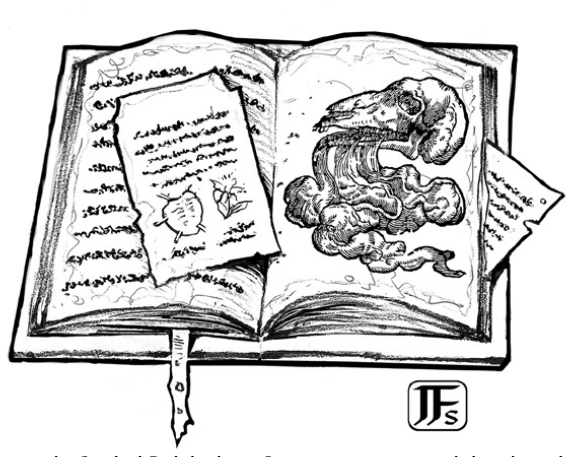
Gross, kind of like those Bloodborne monsters.
Clerical magic is, as usual, mostly a prayer that is actually answered by the priest's god. However, the cleric still has to focus to bring the god's favor to the world, which is why a swift blow can make them lose the god's favor to no effect. Elves channel magic in their own way, similar to High Path magic, which is why elves that have trouble recalling their previous life often need to search for the knowledge they have lost in human repositories of knowledge. They can't use Stitched Path magic, but some wicked elves have sought to surpass their limits becoming Wearers of the Mantle , cutting apart the souls of men and fashioning metaphysical cloaks out of them. There is also word of elven Apotheons burning away all mortality within them. No rules for any of these, though. In normal life, magic users and clerics are relatively rare, and most of the ones that exist can only cast the most basic of spells. Magic users tend to get kind of lousy rates; clerics are more popular, because even though the populace is largely lacking in piety they still want blessings for births and proper funerary rites. We get a table with sample prices for NPC spellcasting, and spells of the sixth level and greater will require an adventure to find someone that can actually produce them, to say nothing of the exorbitant cost.
New spells! The new cleric spells are explicitly not part of the cleric's regular repertoire, and need to be learnt from other clerics of the same faith or from certain rare prayer books. Abjuration of Light (level 3) deals is an AOE spell that deals 1d6 damage per two caster levels on undead and hellish creatures. Lamp of the Nine Immortals (level 2) summons a small lens that lets a cleric Detect Magic, and also determine whether undead have been in the area anywhere in the last week. Maker's Peace (level 1) is present in most faith's rituals despite the name, and deals 1d6+1 damage to a single undead per four cleric levels, with an additional save vs Spells or destruction if the creature has been created in the last two weeks. Martyr's Fury (level 4) is incredibly powerful, but can only be cast if the cleric is fighting on behalf of their faith or an ideal of their beliefs. For the duration of the spell (1 round/level) the cleric automatically hits and deals maximum damage in combat, and can cast any spell they know even if it's not prepared, and succeeds in every saving throw they make and cannot be killed; but at the end of the duration, the cleric burns away in a bright burst of divine energy and their soul is sent to meet their god at once. Resurrection will be impossible, and GMs are advised to disallow this spell to new cleric PCs if the campaign allows for higher-powered replacement characters until said PC ceases to be "disposable."

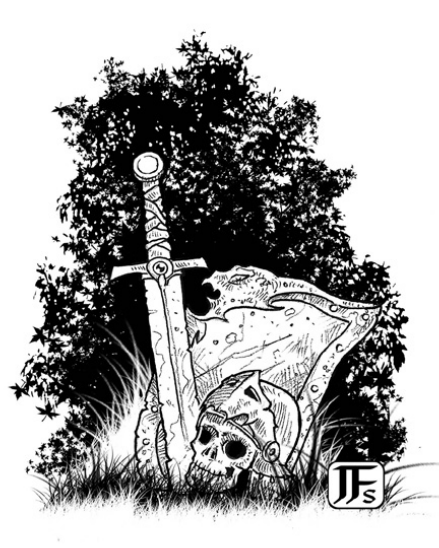
Not seen: all the heathens struck down before the cleric died. Yeah I know clerics don't wear swords in oldschool D&D don't ruin this for me.
Scion wyrds are born from the conjunction of elf soul and human body, giving them an unique capability for modifying reality at their whim. All Possible Knives (level 1) gives the Scion a MMO hammerspace inventory - though encumbrance is still a thing, they can put items no larger than a suit of armor "elsewhere" and bring them back at whim. These items all return to reality if the Scion dies or is rendered unconscious. Solipsistic Forge (level 1) lets the Scion conjure objects out of their own thoughtspace. Any item not larger than a suit of armor can be conjured, but specific replicas can only be done if the Scion has studied it in detail before. The items last for six turns, can only be used by the Scion, and they can create two items a day per level of experience. Walker in Dreams (level 1) lets the Scion "forget" their existence before they remember they actually are in a location within 25 feet. It can be used safely twice a day, any further use requires a save vs Spells or the Scion will be lost in the void forever. Dream Logic (level 2) forces a group of victims (the highest save vs Spells rolls) to perceive the Scion's actions as logical and reasonable no matter how outrageous they are. It lasts for an hour or until someone else not affected by the wyrd points the bizarreness out. Already There (level 3) needs the Scion to concentrate and walk some feet in a straight line, then teleporting next to a target of their choosing. Furthermore, unless circumstances were extremely improbable, the Scion will be assumed by others to have always been there with the target, so you can pull Batmans on people with it. The Other Way (level 4) lets the Scion "take back" a round; it is as if the Scion had done nothing except staying still for a round. It can be triggered once a day even if the Scion was killed in that round, but it can't avoid deaths caused by the actions of others unless those actions were the result of of a choice made in the earlier round. Foreordained (level 5) lets the Scion outright choose the result of a dice roll, with a save vs Spells if the victim wants to; if they don't, when the wyrd is meant to help an ally with an attack roll or saving throw, for instance, that ally's opponent may save vs Spells to overcome the effect.
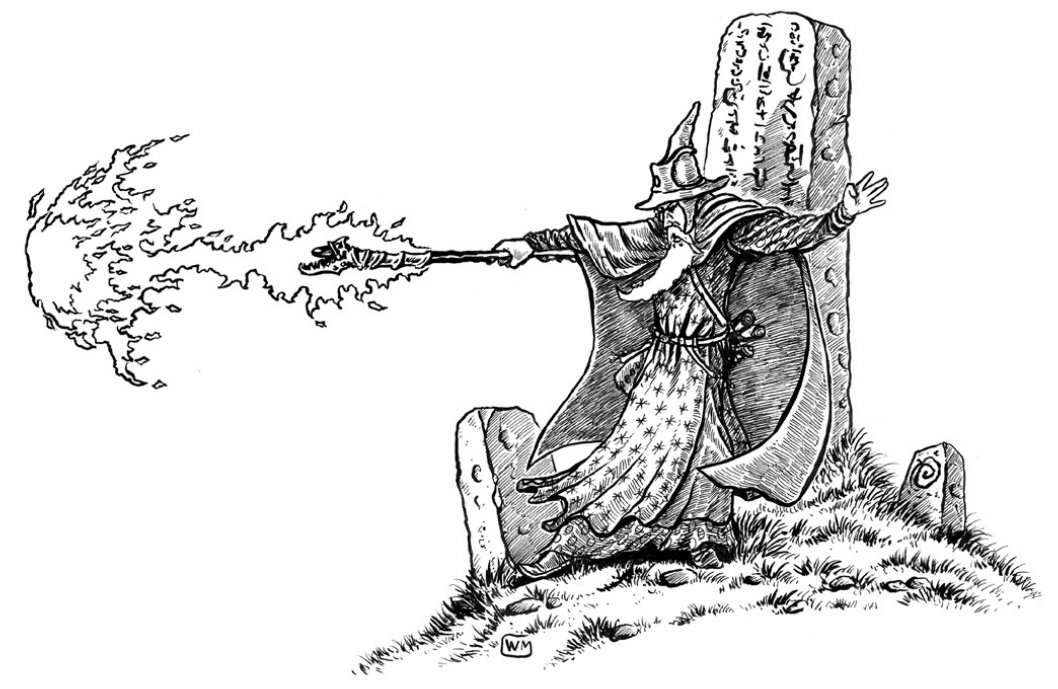
Okay, so wizards dress like this...
Shou witch spells are generally cleric ones (Cure Light Wounds, etc.) along with some unique witch-only spells. These are usually related to nature, other Shou, and beating the shit out of Tide creatures: many of them have special effects if the targets are Tidespawn. For instance, Cleanse the Earth is a powerful 7th level spell that strikes a 20' radius zone with a Dispel Magic, then deals 1d6 damage per level of the witch to any non-Shou spellcaster in the area, with a save vs Spells for half damage. That save is foregone if the targets are Tidespawn or cultists, and the Dispel Magic effect always succeeds. Other spells are Bind Champion (level 1), that allows the witch to share strength with a willing champion, transferring up to 3 points of damage per witch level from the witch to the champion or viceversa. The effect only works once a round, and the witch decides how the damage is apportioned, even dealing fatal wounds to the champion if she so wishes. Shakun's Law (level 1!) is a mass Charm Person that works on 3d6 Shou or creatures with at least one-half Shou blood. Shakun's Scourge (level 4) deals 1d6 damage per witch level up to 10d6, with a save vs Spells for half damage; Tidespawn not only don't get this save, but also take 1d6+1 damage per witch level.
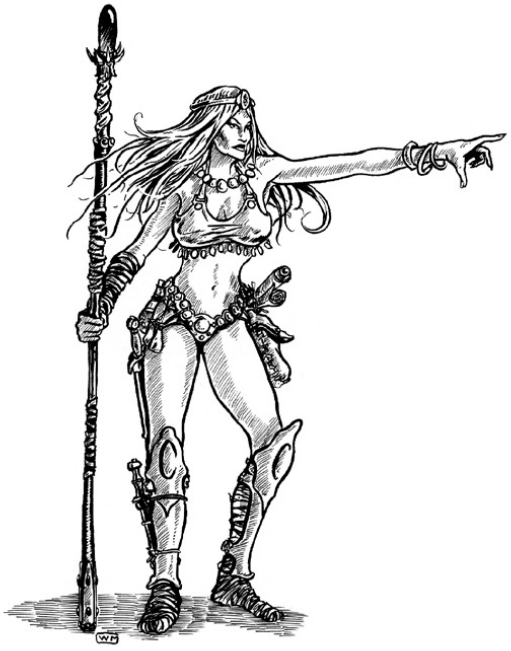
But witches dress like this. Welp.
Magic-user spells are less
 but pretty fluffy and cool.
Auspicious Ward of Comity
lets the spellcaster anoint up to six allies with a rare unguent worth 50gp per person. These allies won't be harmed by the caster's spells, and will automatically save against any of the caster's spells, so it's ideal for the wizard that isn't too finicky about the placement of their AOEs.
Broad Back of the Tireless Laborer
(level 2) lasts one hour per level and lets a target never grow hungry, tired or sleepy no matter how great their exertion, but if the spell is maintained more than 18 hours the target must save vs Poison or fall unconscious.
Jie Tou's Wise Elegance
(level 1) lets the target be maintained clean, neat and dry no matter their surroundings.
Teutohard's Inked Apprehension
(level 2) lets the caster essentially take a picture of a subject on a parchment, magically drawing it in an accurate if pedestrian style.
The Golden Needles of Enthrallment
(level 2) is an "improved" version of Charm Person that needs golden needles worth 100gp to be inserted into the unfortunate target, which will be then hopelessly enthralled to the caster even if their orders are suicidal. The spell reduces the target's Intelligence in 2 points and furthermore, even if the needles are removed the target's spellcasting ability is destroyed unless they receive a Cure Disease.
The Pandect of Inimitable Verity
(level 6) was one of Rai's last spells before he broke with Lammach, and holds Tidespawn at bay from a specially prepared area (500 gp in materials for a temporary one, 5,000 gp for a permanent safepoint). Not only the Tide creatures can't enter or attack anyone in the area, they can't even sense them unless some other being points it out or someone inside the Pandect attacks them, in which case its effect is broken.
The Summons Upon The Way
(level 5) is a special elven spell that lets them revive any elf that has not yet reincarnated. It does not need the elf's remains, but without them the caster must recite their name and that of their last five incarnations, which means that there are many Apotheons waiting for their Summons that won't receive it because their previous names are lost to time and chaos.
but pretty fluffy and cool.
Auspicious Ward of Comity
lets the spellcaster anoint up to six allies with a rare unguent worth 50gp per person. These allies won't be harmed by the caster's spells, and will automatically save against any of the caster's spells, so it's ideal for the wizard that isn't too finicky about the placement of their AOEs.
Broad Back of the Tireless Laborer
(level 2) lasts one hour per level and lets a target never grow hungry, tired or sleepy no matter how great their exertion, but if the spell is maintained more than 18 hours the target must save vs Poison or fall unconscious.
Jie Tou's Wise Elegance
(level 1) lets the target be maintained clean, neat and dry no matter their surroundings.
Teutohard's Inked Apprehension
(level 2) lets the caster essentially take a picture of a subject on a parchment, magically drawing it in an accurate if pedestrian style.
The Golden Needles of Enthrallment
(level 2) is an "improved" version of Charm Person that needs golden needles worth 100gp to be inserted into the unfortunate target, which will be then hopelessly enthralled to the caster even if their orders are suicidal. The spell reduces the target's Intelligence in 2 points and furthermore, even if the needles are removed the target's spellcasting ability is destroyed unless they receive a Cure Disease.
The Pandect of Inimitable Verity
(level 6) was one of Rai's last spells before he broke with Lammach, and holds Tidespawn at bay from a specially prepared area (500 gp in materials for a temporary one, 5,000 gp for a permanent safepoint). Not only the Tide creatures can't enter or attack anyone in the area, they can't even sense them unless some other being points it out or someone inside the Pandect attacks them, in which case its effect is broken.
The Summons Upon The Way
(level 5) is a special elven spell that lets them revive any elf that has not yet reincarnated. It does not need the elf's remains, but without them the caster must recite their name and that of their last five incarnations, which means that there are many Apotheons waiting for their Summons that won't receive it because their previous names are lost to time and chaos.
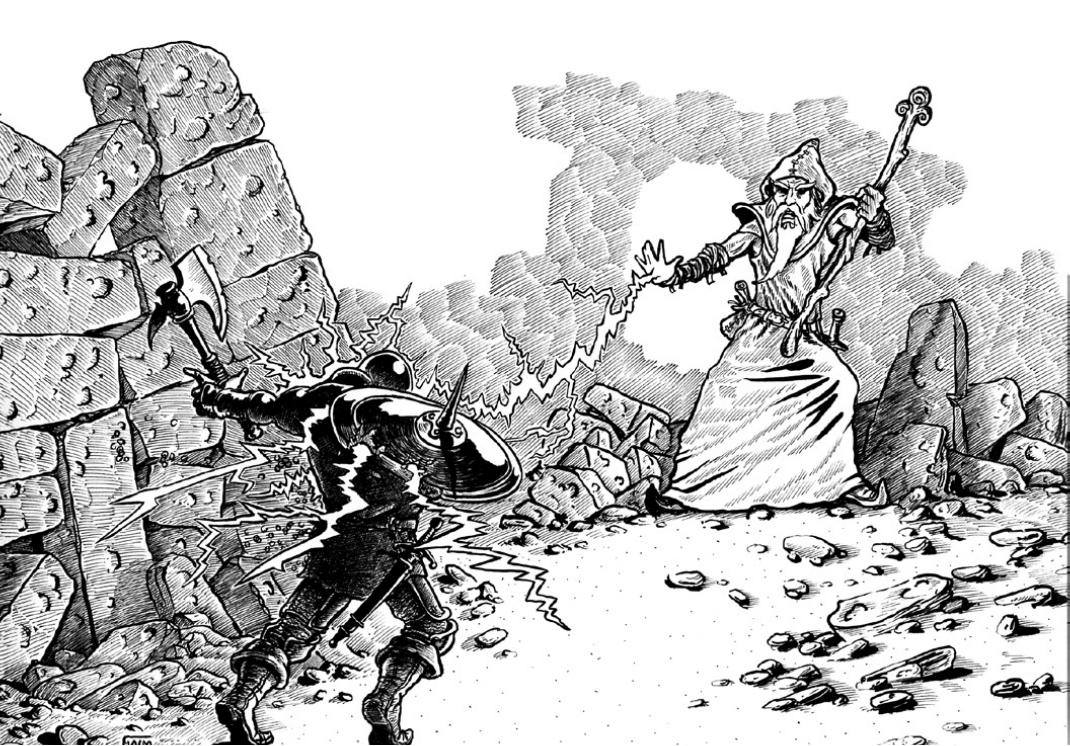
Zap, mothafucka!
Magic items! Here we have the usual assortment of magic items, stuff like Creed Blades (+1 swords or daggers that in the hand of an elf also let them reroll a failed saving throw, and display the principles of their Creed along the blade) or the Skull of the Longfathers (prepared by a dwarf craftswoman by inlaying the skull of a loved husband with precious gems, it lets the bearer resist up to 50 damage points before cracking and losing its power). The most important item here is godbone : this mineral that can only be found in the Isles has all sorts of beneficial effects. Carrying a pound of raw godbone grants the bearer a Protection from Evil effect that applies to Tidespawn and cultists, and witches know secrets to fashion arms and armor out of them that also carries that protective effect, as well as granting extra defense or offense against extraplanar creatures. Furthermore, godbone can augment spells: using one pound of it as a spell component maximizes any random effect from the spell (like damage rolls) or lets the caster roll up to three times and take the best roll if the spell forces a roll on a table or similar. In Tien Lung, sorcerers make a point of purchasing or confiscating any godbone they can find, and a single pound can reach up to a thousand gold koku in the markets of Xian and Hohnberg.
And now, item styles! These have no effect but are really cool. GMs that wish to make items distinct can roll or choose from a table to see just how a magic item looks, depending on the culture that created it. For instance, take the common potion of Cure Light Wounds. An Imperial potion will be bottled in a thumb-sized jade vial that can be distinguished by touch, ideal for soldiers in the middle of battle. It can be a Kueh bamboo vial or a flower bloom that must be crushed to gain the effect. The Eirengarders have unguents carried in small glass tablets that must be anointed on the target while saying a prayer, while the Gadaal bake pastries made from dubious if auspicious ingredients, and an Ekshanti "potion" will be a perfume that must be smelled before the effect takes place (and can later be used as regular perfume
 ) Even a poison found in ancient ruins may actually be a combat potion made for creatures that have non-human physiologies. By the same token, a suit of enchanted plate may be well-made Imperial lamellar, a superheavy Eirengarder suit enchanted not for extra protection but to allow someone to move inside of it in the first place, a pair of Gadaal boots made under such auspicious circumstances that the wearer is as hard to harm as someone in full armor, or some incredibly weird elven armor that seems to be full of weak points but somehow forces reality to accept that it actually protects. Even a scroll can be a Kueh ofuda charm, a Gadaal copper plate that turns into verdigris flakes as it is read, or a rubbery ball of elven manufacture that spreads over the caster's forearm when held tightly and reveals a readable magic pattern.
) Even a poison found in ancient ruins may actually be a combat potion made for creatures that have non-human physiologies. By the same token, a suit of enchanted plate may be well-made Imperial lamellar, a superheavy Eirengarder suit enchanted not for extra protection but to allow someone to move inside of it in the first place, a pair of Gadaal boots made under such auspicious circumstances that the wearer is as hard to harm as someone in full armor, or some incredibly weird elven armor that seems to be full of weak points but somehow forces reality to accept that it actually protects. Even a scroll can be a Kueh ofuda charm, a Gadaal copper plate that turns into verdigris flakes as it is read, or a rubbery ball of elven manufacture that spreads over the caster's forearm when held tightly and reveals a readable magic pattern.
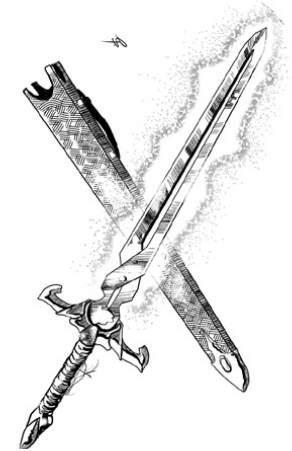
No, actually this is going to cut the shit out of you and not break on the first parry. Magic!
Next: more

Shit, I have a game in one hour and I have nothing to show, what do
Original SA post Red TideShit, I have a game in one hour and I have nothing to show, what do
Here we get into Red Tide's set of GM-side tools for a sandbox game. Defining what "sandbox" means is important, as it's one of those terms that means different things for different people. For Crawford, a sandbox game is one where there is no overarching plot - there's no commitment to have any particular event come to pass in the campaign, no fear of the PCs "doing the wrong thing for the story" or "losing the plot." Yes, a GM can run a great story-driven game, but this isn't what it's about. A sandbox game is what the players are doing: if their goal is to take down a corrupt Xianese noble one way or another, that's it. If they later escape the noble because he's too tough to take down on their own and they need to rally a Westmark settlement to fight back against the noble, that's the game. And if several sessions later they've completely forgotten about the noble and are trying to fend off a savage Shou onslaught, then that is what the game is about. The players are the focus of the campaign, and everything else simply exists to give them interesting things to do. But the sandbox world is also alive, and actions have consequences: if the PCs finally kill the corrupt noble, his domain will fall into chaos and infighting. If they leave his daughter alive, she'll send assassins after them half a year later. The PCs get to see the results of everything they do, and NPCs react appropriately.
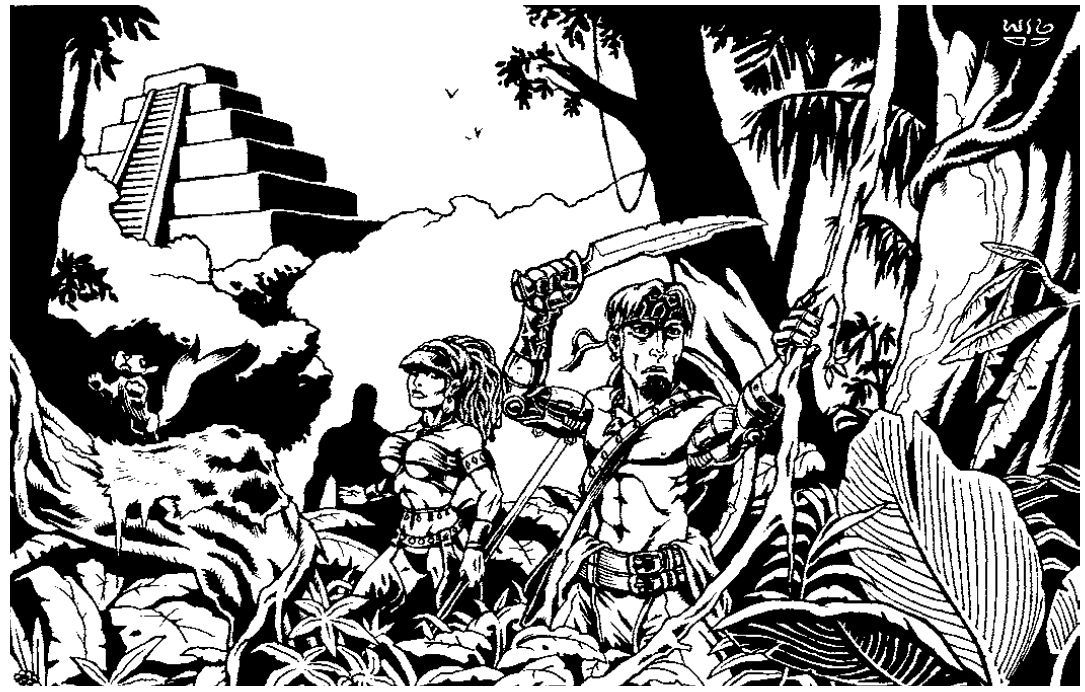
Dude's hairdo sucks.
So how does a GM go on about running a sandbox game? First, it must be made clear to players that they are the main driving force of the game. The GM will provide things to do, yes, but they're the ones that have to bring a goal into the game, even if it's something as simple as "fight evil" or "get rich." Players should also understand that the world isn't automatically scaled to their level - there will be dangers that the PCs won't be able to face immediately, and if a situation looks lethally dangerous most often it will be. The GM won't be shoving them into no-win situations, but if the players foolishly charge into a peril after receiving warning well in advance that's their problem. But the GM also has a series of duties: making judgment calls on the player's actions and how the world reacts around them, giving them opportunities for their ambitions, and preparing the sandbox for them to play in. The advice here is eminently practical: a GM should have a folder - an actual, physical folder - with many pockets, divided into sections of People, Places, Encounter, Chronicle and Maps. The People section includes the particulars of any NPC the PCs meet, which at first doesn't have to be anything other than a name, occupation and location, with space left for further notes as the game progresses. Places contains brief writeups of towns, villages, monasteries, estates and other locations of importance, with notes on important NPCs and events, and what the PCs' actions do to said places. Encounters has sheets of pregenerated NPC and monster stats; these stats can later be reskinned for recycling, since the game is coarse enough that players most likely won't notice if a Shou warrior rolls the same numbers as a tong hatchetman. Chronicle carries the ongoing log of the campaign, to have a reference that can later be checked on to see what the PCs were doing months ago. And finally, Maps are always useful, but particularly if PCs are expected to fight. You don't need a detailed map of a village if the PCs are just buying supplies and gathering information, but you do need it if the PCs are manning the stockades against an orc raid.
The folder needs to be stocked, of course. Eventually a GM should be able to pull a night's game just from the folder's references, but at the beginning they will have to put on some time filling it with resources. PCs will need a home base, but since at this point probably not even the players know what they will play you don't want to over commit, so you should make at least two barebones home base locations without burning yourself out on either of them. One should be a city (Xian, for instance), with notes on important services, merchants and some color NPCs. This place should be easily able to be reskinned if the players want to say start in Hohnberg instead, just changing some names and references around. The other potential home base should be a borderlands settlement, closer to ruins. Whatever they pick, keep the other writeup at hand - it will come in handy. After that, you'll need to generate other places of interest, and the home bases should also have options for social and exploratory play for PCs that want them. Finally, the group should have a first adventure to kick things off with - it should be something that gets the PCs together quickly, gives them an immediate goal, should have an easy way to introduce new PCs if one bites it early on (it is oldschool D&D after all
 ) and finally should free them to go off on their own later. After that, with an idea of what the players want to do later, you should start generating new places and hooks for them, and if inspiration hits you then by all means go nuts - but everything should be
usable
, reskinnable.
) and finally should free them to go off on their own later. After that, with an idea of what the players want to do later, you should start generating new places and hooks for them, and if inspiration hits you then by all means go nuts - but everything should be
usable
, reskinnable.
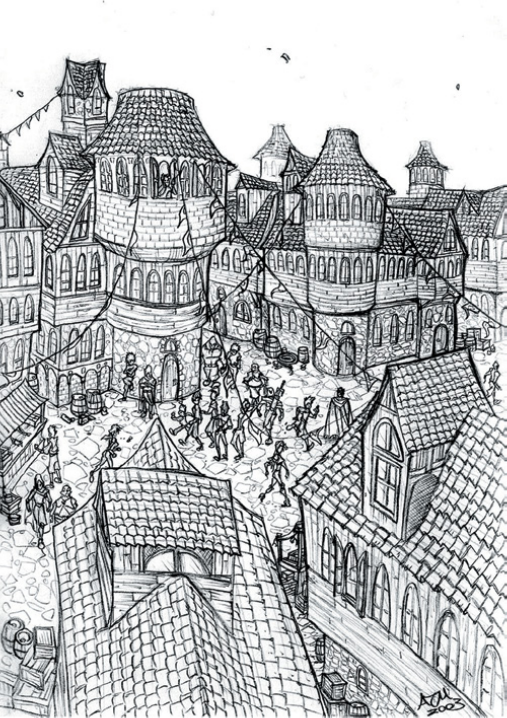
Not seen: the PCs ransacking the place.
Between sessions, you use the log and what the players have told you they want to generate content for them. If they want a nobleman's help to depose a tyrannical magistrate, then generate the nobleman's court, and think of the challenges in getting an audience with such an important fellow. You don't need to plan for every single contingency, but you should have at least a session's worth of material together. Sometimes PCs want things that won't take them a full session to solve - then the GM has to think of their immediate goal after that and plan accordingly. If they come out with a wild swerve, that's why the campaign folder is for: pull something they haven't seen, change some names around, and bam. Above all, there is a golden rule that even gets a sidebar: don't prepare things unless they're fun to make or you expect to need in the next session. Don't burn yourself out making things you don't want. GM burnout kills campaigns faster than anything else.
To help in the job of creating and maintaining the box, Red Tide has several tools for the GM. Here we have rules to create sites. A site is a place of interest, a place that is worth the player's attention. They're not intended to replace creativity, but are meant to be (a point that Crawford comes back to time and again) a way to simplify a GM's life when it comes to giving life to a campaign. Sites come in court , urban , borderland and ruin flavors. Court sites are places of intrigue: rather than actual locations, here we're trying to present the web of relationships of multiple NPCs and the conflicts that emanate from them. First you choose the location of the court (because an actual noble court is different from an academy which is different from a business and so on), then you define how many people of importance are there (the ones with real power), the details of their sources of power , and finally the conflicts , and what happens to whom when they're resolved one way or another.. The site rules include several tables to roll on, but the GM should feel free to just pick a result or make stuff up: these are only meant to help, not dictate slavishly. For instance, I rolled a temple where the figures of importance are a noble-turned-monk and a somewhat heretical priest. The noble is loved by the temple's peasants and servants, but the priest actually has clerical powers. I roll a conflict and get "Folly: one of the people is making a terrible hash of their duties but will not give it up." Already I see that the priest's power has gotten to their head, and the noble can't go against the priest directly due to the actual, provable divine connection. Some other NPCs are rolled: a seller of religious supplies (the priest's dealer?) a maidservant (follower of the noble since before they took the cloth, loyal unto death), a desperately hopeful petitioner (what would they be able to do just to get the priest to cast one spell?) and a curious scholar (an outsider like the PCs, here to chronicle the deviant beliefs of the priest perhaps). Suddenly, I have something for the PCs to do tonight.
Borderland sites are the places between the tamed lands of men and the wildlands where Shou and other perils exist. They're often visited by adventurers, as they're the last outposts of civilization before entering the wilderness. But of course, these people live hard lives, and sometimes they could use an adventurer's hand, or their sword. Similar to the court, we first roll its location (dwarven delve? elven enclave? mining hamlet? trading post?) and then we roll or choose tags for it. Tags are familiar to Stars Without Number GMs, they're basically one entry that specifies a particular quality of the location, and include lists of possible friends , enemies , complications , things and places . For instance, let's say a tag is "Bungling Leadership": the settlement's leader is hopelessly incompetent. Enemies may be the fumbling leader, or a secret power behind their throne. Friends may include a relative that wants to save the leader from themselves, or an elder that sees the problem. Complications can be stuff like the incompetent leader being personally powerful or the only acceptable leader by local customs. Things may be a relic that gives the leader legitimacy, or proof that their advisors are corrupt. Places can be a confused and riotous audience hall, or a decaying, unrepaired wall. These sites have one or two tags, and they can be blended at the GM's pleasure: a delve tagged with Dwarven Outcasts and Faded Glory may be a settlement dominated by the inbred remnants of a once-great dwarf clan. The site should also have services for the PCs to take advantage of before going adventuring, and of course there should be stats for guards and the like, maps of interesting local features, and a hook or two that can give the players reason to take a closer look. Even if they're not immediately interested in the hooks, they can be called back on later, giving the illusion of foreshadowing. City sites are similar in construction to borderlands sites, with different tables to roll on. Cities in the Isles are generally small, with Xian the largest at no more than 12,000 people. Still, if players want a real metropolis these numbers can use an extra zero at the end. After all, if the players aren't "hardcore realism fiends" they won't be analyzing the map hex by hex for arable land and how much population it can support. More attention is given to the social fabric of a city site than a borderlands one: there will be legal systems to contend with, for instance. And of course, there should be hooks for the players to have something to do in cities.
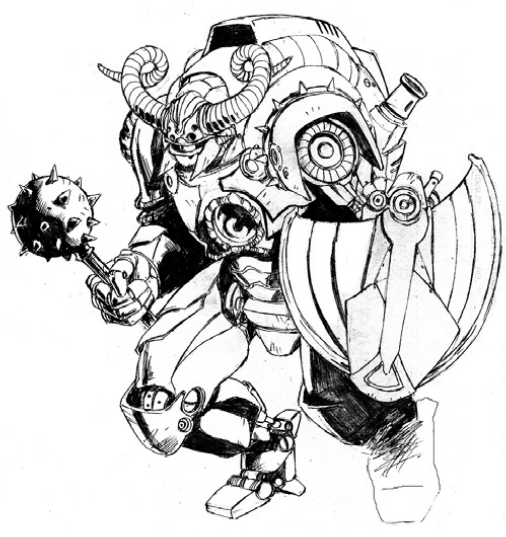
Pick up that can.
Ruin sites are the most interesting in construction. You first choose the ruin type, then determine how it became a ruin: though there are tables to do this, rolling in the borderlands tables and extrapolating can be useful: a small colony that suffered a catastrophic Crop Failure, perhaps? Then, you choose the ruin's inhabitants. Red Tide comes with 20 pre-made encounter sheets for different kinds of possible ruin dwellers. Each sheet includes stats for different types of NPCs and monsters, possible treasure they can have, and notes on how to scale each encounter to easy (roughly for 1-3 level parties), medium (4-6) and hard (7-9) difficulties. They also come with a table to introduce complications and twists to their presence. For instance, what if the Exiled Noble and his cronies holing up in this abandoned castle were actually innocent of the crime the noble was charged with? What if these Dwarven Outcasts are Repenters, willing servants of the Mother Below? What if this Shou tribe was led by its witch here to terminate a local Tide Cult, that has masked its true nature and convinced most of its rank and file followers that they worship different spiritual masters? With these sheets and the maps provided by the game, you can have a game's dungeon bash in less than thirty minutes, and if the players don't take up the hooks leading them to it then it's no biggie - save the encounter, reskin it for later.
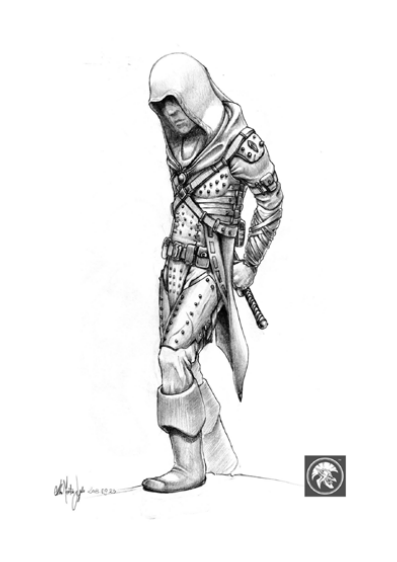
Budget Altair on the job.
Next: wow I managed to write all that and skip the bestiary section, welp
I'll show you how to kill a god
Original SA post Red TideI'll show you how to kill a god
The bestiary section comes before the GMing section but I managed to skip it. Oh well!
We first start with Constructs. A fad in the pre-Tide Empire was the creation of artificial servants for all types of duties, from manual labor to warfare. Even small armies of these constructs were built, but the fad died when the prices for the materials needed in their construction became so expensive that it was cheaper to pay a day laborer than building a tireless servant with magic. They became toys for the wealthy, and in the Isles they are very rare, usually only found in ruins or guarding things. Constructs are all immune to sleep, hold and charm effects, and never need to eat, drink, sleep or breathe. They come in civilian and military flavors: Men of Jade and Clay are 2+2 HD creatures mass produced for agricultural labor and simple, but repetitive tasks. They're stupid by human standards, but can reason their way around obstacles and speak the language of their builders. Porcelain Servitors are less sturdy (1+1 HD) but more beautiful and intelligent, made for duties that involve interaction with humans. Some of these have managed to subvert their original programming in the centuries after the exile, approaching true intelligence. Military constructs are meant for warfare, limited in intelligence even compared to a Man of Jade and Clay: Ancient War Golems have 8 HD and hit with two powerful 1d12 attacks, while Black Juggenauts have 10 HD, two 2d6 attacks from the war scythes implanted in their bodies, and a 2d10 geomantic cannon installed in their chest. Fortunately, they can be stopped and put to service by means of keywords or override wands, but where even are you going to find one of those?
Demons come from Hell. No one can deny that the Hell Kings exist and they hunger for souls. All demons an speak and understand all languages, have 90' infravision, can cast Detect Magic and Detect Invisible at will, are immune to fire damage and only take half damage from cold and electrical attacks. They cannot be poisoned and are immune to disease, and cannot be injured by unenchanted weapons. However, they're prone to underestimating mortals, gloating about their plans in detail when they should just finish them off and so on. Lesser Demons are fashioned from "fortunate" souls whose wickedness in life pleased the Hell Kings. They're twisted into horrible shapes, bent to the will of the Kings, and while some retain memories of their past lives none can defy their masters. They have 8 HD, three attacks and can petition their masters for the use of a single spell of 3rd level or lower, but they have a weakness shown in the way in which they were warped by the Hell Kings: a demon bound by spikes of ice takes double damage from frost attacks, cruel piercings make them take double damage from edged weapons, and so on. If they show no particular weakness, they take damage only from enchanted weapons. A Mandarin is elevated from the lesser demons to become a closer servant of the Hell Kings. They're the ones charged with more subtle work: secret cells hidden even within other infernal cults, and so on. They have an AC of -1, 12 HD, and hit with powerful 1d8 fists and a 1d12 curse that hits enemies up to 300' away. They can only be harmed by +2 or better weapons. Finally, a Hell King is a terrible thing, growing more daring to strike openly at the world with the Red Tide keeping the gods from interfering. They have 99 HP, attack with a 2d20 hell gaze that harms anyone except the most pure of individuals (so it is said), fail saves only on a roll of 1 or 2 and regenerate 5 HP per round. They may cast any spell except Wish.

Being a demon is a shit deal, honest.
Celestial devils are the servants of the gods in their most negative aspect. So strict they are that no mortal ever measures up to them, and so they're always Chaotic by LL's alignment standards. With 15 HD and three attacks, as well as all clerical spells and the ability to Teleport without fail they would be dangerous enemies already, but they also can't be harmed by any type of weapon, even enchanted ones. Only spells and weapons especially consecrated to the destruction of the divine or extraplanar creatures may harm them: the exception are those wielded by fighters of 16th level or better (because they're that badass
 ) or by dwarves of 8th level or better (because
the murder of gods is in their blood
) or by dwarves of 8th level or better (because
the murder of gods is in their blood


 )
)
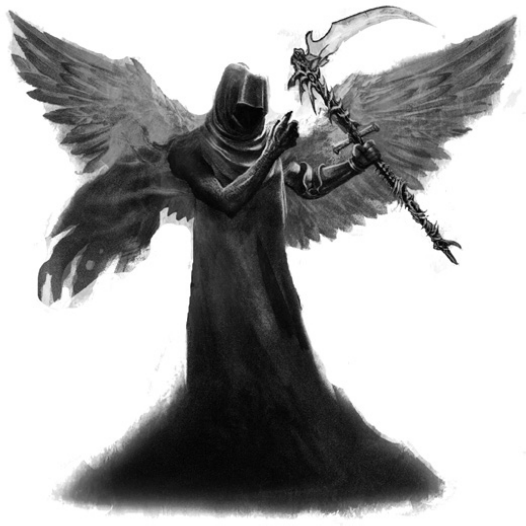
Bdazz
Lizardfolk live along the jungles and warm coasts. They sometimes look humanoid, sometimes as half-snake half-man hybrids, some look almost wholly human except by a trait like a forked tongue. They're divided between standard lizardmen and Old Sleepers , said to be great heroes of a forgotten lizardfolk empire that existed before mankind. The Old Sleepers fell into deep slumber, to awaken in their people's time of need. They have the powers of a 7th level magical user.
Ogres are interesting, closer to Ravenloft than the traditional D&D ogre. An ogre is an evil human whose wickedness caused them to be possessed by spirits of evil. They're hideous in appearance, but they have the ability to disguise themselves perfectly as a regular human being with just some concentration. Only a child's touch can break the disguise. Ogres retreat not too far from civilization, to live alone or in groups of like-minded degenerates and raid the human settlements for people to "slake their unholy desires" with. Mercifully, we're not described what exactly ogres do, but they're explicitly mentioned to be created not by birth so there's that. Goddammit, Pathfinder.
Shou , we already know. They're the setting's orcs, goblins, bugbears and hobgoblins. Aside from their anti-Tide abilities we saw in the character section and the fact that hobgoblins raise fellow goblins' morale to 9 (they seem to have an innate understanding of squad-based tactics and warfare), they're just the same ol' gribblies.
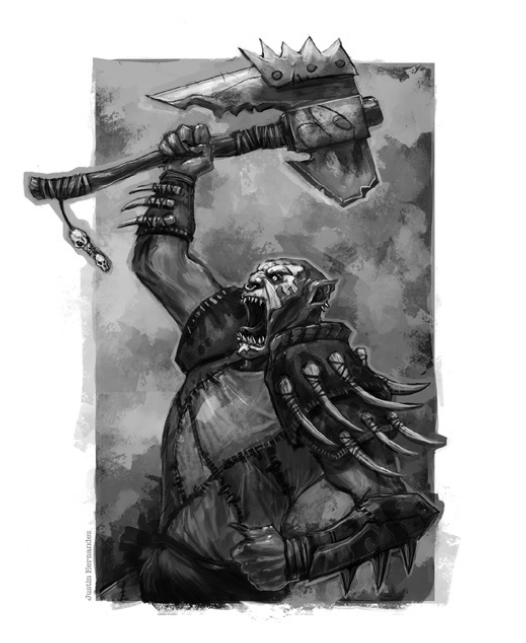
WAAAAGH

Tidespawn! Now we're talking. These are usually fashioned from the people captured by the mist, with only the vaguest remnant of self-awareness. Sometimes the Tide lashes out a tendril to reach the shores, or sometimes Tide Cults summon them into existence inland. They used to be horror stories and little more, but in the last twenty years or so the numbers of Tide Cults have risen rapidly. Weak-willed men and women are tempted by dreams of the Tide to undertake small rituals that bring them a delusive sense of good fortune and abundance while warping their bodies and souls. The lucky ones are caught and executed before they can fully realize what they have become. Creepers are created from small humans, children and halflings. They fight in mad packs, and while they're very weak (1d4 HP, 1d2 or weapon-1 damage) they cause a sense of disorientation with their presence, giving normal creatures -1 to attack and +1 to AC as long as one Creeper is around. Magistrates of Ashes are rarely seen by humans (or rather, they rarely survive to report their findings.) They seem to be some sort of middleman position for the Tide, relaying orders and planning incursions into the isles. It vaguely resembles an Imperial magistrate, clouded with embers and smoke, and likes to teleport around and near foes causing 1d4 fire damage from their blast. They can claw their enemies for 1d6 damage, have 10 HD and can also cast a 2d6 firebolt, but take double damage from cold or frost attacks. Red Apostles are husks of wretched Tide devotees, unsuitable for the inscrutable purposes of their masters. Rather than turned into the other types of Tidespawn, they're wracked with a painful disease that can only be allayed by exhaling cones of burning meat and bone (AOE, 1d6 damage with save for breath weapon) They retain a surprising amount of awareness, and can "encourage" lesser Tidespawn to fight harder, dealing 1d6 damage to them and giving them +4 to hit. Stretched Ones are, well, that - probably humans or demihumans, whose torsos and limbs were elongated to grotesque lengths. They shamble and creep along the ground at great speed, fighting with their limbs or chains of vertebrae, and love to work in pairs to flank opponents. White Chanters are described as gaunt creatures with limbs at strange angles, droning a steady mutter of gibberish. They appear to maintain their intelligence, forming simple but effective battle plans and attacking with 1d8 shriek attacks, and they cause delirium in others with their sole presence (save vs Spells each round, else roll 4+ in 1d6 or be able to only defend). Wormwalkers are THE WORM THAT WALKS HOLY SHIT, and attack with worm tendrils for 1d4 damage - which wouldn't be so bad, except they have three attacks and wounded foes that come close automatically take 1d4 damage as the worms attempt to get into their open wounds. To make it worse, the first time a wounded enemy approaches a Wormwalker they are attacked by an especially large worm (1d6 damage) that attempts to impale them, if the attack is successful the worm deals 1d6 damage until someone slices it off. Any humanoid brought to 0 HP by this damage will become a Wormwalker within the hour without a Cure Disease. Finally, Dream Lords are both commanders and nodes of the Tide infestation. They manifest as echoes of old world rulers, so there's a false Emperor of the Ninefold Celestial Empire ruling where it used to be. They distort reality around them, and True Seeing will be the only way to avoid near instantaneous obliteration. Furthermore, even if a party can get close to a Dream Lord (which entails going into the Tide ), the Lord is invulnerable until it is proven that it is not in fact the real lord of the place: in the case of the false Emperor, the party should present the original Tablet of Heaven given by the last true Emperor to Lammach before the escape, but that treasure has been lost to time. If this is done, all the PCs have to do is fight a 125-HP freak that casts any spell it wants once a round and attacks with horrible 2d20-damage visions that cause a save vs Spells or die, aside from their myriad servants and the corruption of the tide... but if a Dream Lord is killed, entire nations can be cleansed from the Tide's corruption in one swoop. Epic campaign time!
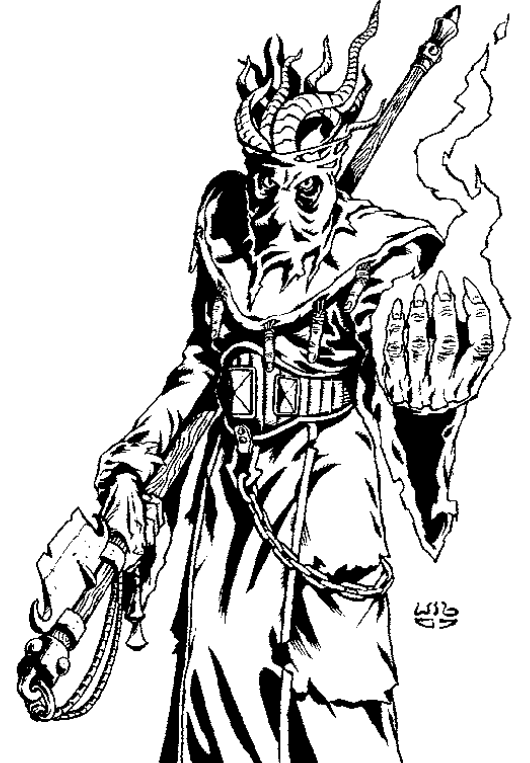
If you walk without rhythm, you'll never learn.
Next: SPOILERS AHEAD
Suddenly, Fantasy Delta Green
Original SA post Red TideSuddenly, Fantasy Delta Green
Now we're on the last stretch, with the game's secrets revealed. After the usual warning to players to look away, we dive into the nature of the Red Tide . It is, essentially, a predator of planes: some sort of cancerous physical law, like gravity with a grudge. Its origins are completely unknown (maybe a grand ritual gone wrong, maybe it just happened) but whatever it really is, what the Red Tide does is tunneling between the planes, reaching new ones full of sentient life, and devouring them. It bleeds into a world and uses the dreams and fears of its denizens to create horrors, allowing them to generate their own methods of destruction. Plants and animals aren't aware enough to trigger this, however, and non-living thinking creatures are somehow indigestible to the Tide, so constructs and undead are only attacked if they do something to bar the advance of the mist. Gods are usually too fractioned and embroiled in their own petty fights to present any threat to the Tide, and in any case it is impersonal enough that divine power can't just erase it, any more that it could erase gravity, light or time. Plus, there's the issue of the cosmic interference that prevents clear communication between gods and their mortal servants. The Tide takes hold in the most inhabited areas first, creating Dream Lords and other monsters to serve them. For the most part, these just exist, rarely having active purposes. When a world tries to fight back or check the Tide, it sends feelers into the pockets of resistance, tempting the weak-willed into undertaking rituals that will ultimately transform them into Tidespawn or nodes for them to appear inside the safe areas. Once the Tide has completely infested a world, it settles down and starts digesting all the Tidespawn, rendering down to their most base components of their ego. Once the last gribbly perishes and the last Dream Lord falls, the Tide is fed enough to tunnel through to the next plane. For countless ages, this process happened without a flaw, but the world before this one fought back too hard, and now the Tide is in danger: if it does not destroy the Sunset Isles soon, it may not have enough energy to escape this plane.
The Tide serves as a constant background threat, the abomination that will force the peoples of the Isles to band together or the death kneel for the world. It serves as a long-term enemy, as it's very likely that a group of powerful PCs will eventually seek to confront and push the Tide back or wipe it out completely. It serves as an implacable alien horror, for GMs that want something more Lovecraftian in their games, and it's good as a source of pulp cultists and gribblies for heroes to crash - or to set the scene for the awful culling of wretched half-innocents that never really understood what they were getting into. However, it is advised to the GM that they shouldn't lay it on too thick - the PCs should never feel that all their actions are hopeless because of the Tide, as this may trample the freedom that makes a sandbox game in the first place. If players don't want the game to be about an endless struggle against the Tide, it shouldn't be.
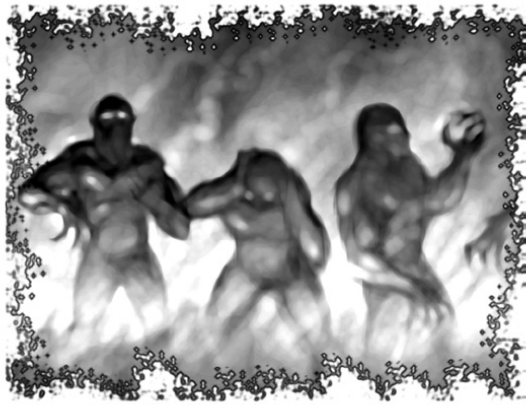
The Tide Boogie, the end of us all.
The Shou are not, in fact, natives to this plane. Neither are the Isles, for that matter. The Shou were an advanced civilization in their own world, blending magic, science, and the favor of their god Shakun, Lord of the Pillars of the Sky and sole survivor of millenia of divine conflict. When the Red Tide first crashed into this world, Shakun was ready and willing to fight back immediately, and along with his people he trapped the tide in containment zones all over the world. Unfortunately, the warping of reality needed to maintain these zones frayed the laws of reality, like tears in fabric that was too strained. It was only a temporary solution, but the Shou reasoned that if the Tidespawn could be exterminated, the Tide would starve and perish. And so, the scientists and priestesses of the Shou developed a new breed of warriors, hardy and resistant to the ravages of the Tide. Orcs were the frontline warriors, goblins were skirmishers and scouts, bugbears were shock troopers and special forces, and hobgoblins were born officers and leaders. Their martial virtues and innate resistance made them perfect for the job of slaying the Tidespawn, but the Shou were too late - by the time the bloodlines were perfected, the Tide had broken out of the containment zones, and there were not enough of the new supersoldiers to hold them back. Shakun called his hierarchs to him and commanded that the new Shou warriors be brought to an island archipelago that served as one of their civilization's last redoubts. With all the other Shou sacrificing themselves to buy them time, Shakun made the ultimate sacrifice: burning his divine essence, he transported the isles and their inhabitants to a new world. The effort burned the god's body, leaving only his skeleton buried in the soil of the isles. When witches say that godbone is the remains of Shakun, they speak literal truth. The primitive humans of the world could not realize that the geography had changed, and the lizardfolk civilizations that ruled in that time were in their decline and could do nothing about it. However, the Isles were surrounded by sea monsters, and not enough "civilian" Shou made the planar jump, so in a couple hundred years what was left of their civilization collapsed. The tribal Shou lived, bred and fought each other, struggling to prove their worth to Shakun, until the exiles arrive and drove them back. Some Shou believe that they brought the red malaise with them, the mist and the monsters that they hate down to the marrow of their bones, but some of the most forward-thinking priestesses and chieftains wonder if that is not the case, and if the newcomers can be allies in the fight against their ancestral enemy.
So how can Shou be used in a game? On one hand, they can be the traditional D&D goblinoids, sacks of XP and loot for players to bash without much worry. And hey, it's true that many Shou are in fact dicks that want to kill, enslave and eat, and perhaps not necessarily in this order. With some player groups, this might be the ticket. You can apply a more nuanced point of view, but players probably won't appreciate being saddled with a bawling Shou girl after they killed her dad if all they want is kill morally acceptable targets. For less murderous games, players should always have non-violent solutions in dealing with the Shou: tribes that can be reasoned with or take up the remnants of vanquished tribes, spaces for exchanges of prisoners and information. And perhaps players want a more morally ambiguous feeling: yeah, the Shou are savages, but the fact of the matter is that they are the natives of the Isles, and they presented no danger to civilization until the exiles arrived. And yes, the exiles were desperate in their escape from the Tide, but they did slaughter the natives and clear the land for their own use. Some players may want to establish alliances with the Shou, and while the GM can make the goal hard to start with and hard to follow through, they should have a chance of success if the players show genuine interest. And eventually a player will want to play a Shou: in this case, odds are the player will want to play out a hero that is shunned by the same people they try to protect, so while the player should sample that life should not be made impossible by their choice. It's okay if the Shou or half-Shou PC hears muttering and cursing behind their back when in town; they shouldn't be put on a leash outside every time the party wants to have a civil conversation.
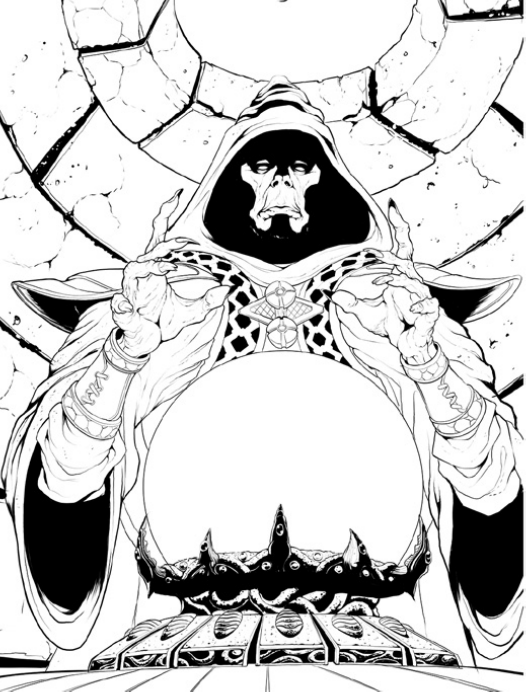
Oh shit, a Shou sorceror--- what do you mean he's the GOOD guy?
The Azure Ministry can be a tool to bring Shou PCs and the battle against the Tide into the game. There's a small island called Qincheng off the coast of Ektau, where it is said that the Azure Ministry conducts hideous experiments on Shou and half-Shou prisoners. Yellow-sailed ships leave hooded condemned there, and for sea captains they are ill omens. But the truth is different. It all comes back to Lammach's death. When the exiles arrived, they thought the Shou could be tamed as other peoples had been subsumed into Imperial culture, and part of that was the traditional custom of marrying Imperial mandarins into powerful local bloodlines. And so Lammach chose a wife called Ihlati , a powerful priestess. What no one counted on was that the Shou were too warlike to surrender to the foreigners, and that Lammach and Ihlati actually fell in love with each other. She was at his side when the raiders that killed him broke into their tent, and though she could not save them she blasted his killers into a heap with her powers. Lammach's son, the future mandarin, rushed to help his father, and immediately understood what happened - and also understood that the exiles would never forgive Ihlati. So, he spirited her and her thralls to Qincheng, to be "questioned": the truth, as both the prisoners and their wardens learned upon arriving to the island, was that they would be protected against all harm. Eventually, the Shou and their wardens even married each other. Ihlati passed on the lore of witchcraft to promising young disciples, and one of them in fact managed to root out a Tide Cult started by one of the Ministry wardens on her own. Ihlati realized that they could still serve the Isles even if they were hated, and the Ministry was too ashamed by the cult springing amongst their own to protest. They trained agents and brought in halfbreeds from the Isles, who while embitterered by their treatment still embraced the opportunity to have a place, to do noble work. The Ministry agents infiltrated towns and villages, scourging Tide cults and their spawn, but in the deepest secret: more than once, "Shou killers" have been lynched by the mob after slaughtering an "innocent" family. Agents are sworn never to reveal their identity, and they're bound by sorcery to protect that oath. But now the Tide Cults are sprouting faster than they can be rooted out, and agents are reaching the extremes of hiring adventurers as enforcers and muscle. Some voices in the Ministry don't care about the collateral damage inflicted by their destruction of the cults, and some nurse dreams of letting the humans and demihumans know who - or what - has protected them for three hundred years. For now, the Ministry remains silent, but the rising Tide may not let them conceal their secrets for much longer.
Finally, we get some more tables for the GM to roll in. Hey, it is an OSR game after all. You want a quickly done cult?
 Okay, this cult worships a maddened prophet of doom, possesses secret popular support, has a local business leader as an agent among the masses and the devotees have a special language - hey, I think I just rolled Dittoheads.
Okay, this cult worships a maddened prophet of doom, possesses secret popular support, has a local business leader as an agent among the masses and the devotees have a special language - hey, I think I just rolled Dittoheads.
 We also get name and place tables for all the different cultures in the setting, along with naming conventions and notes on clothing and cuisine.These tables will be familiar to readers of Stars Without Number, that also include them for real-world cultures, and kudos for Crawford for not simply copypasting the real-world tables to their fantasy equivalents (Russian for Dwarves, German for Eirengarders, English for Halflings, Chinese for Imperials, Japanese for Kueh and Arabic for Ekshanti)
We also get name and place tables for all the different cultures in the setting, along with naming conventions and notes on clothing and cuisine.These tables will be familiar to readers of Stars Without Number, that also include them for real-world cultures, and kudos for Crawford for not simply copypasting the real-world tables to their fantasy equivalents (Russian for Dwarves, German for Eirengarders, English for Halflings, Chinese for Imperials, Japanese for Kueh and Arabic for Ekshanti)
Dwarves have use-names and blood-names, where the use-name is a personal name followed by a clan name usually rendered in the Imperial language (Vasily Orefinder, Svetlana Greathammer), while blood-names are endless lists of same-gender ancestors. Vasily son of Piotyr son of Leonid son of Nikita son of... and so on. Place names tend to be adjective-noun words: Goldhall, Redstone, Deepthrone. Eirengarder names use a personal name and a surname, and in their tradition the first child of a couple takes the father's surname, the second takes the mother's, and so on. This was done to spread surnames widely, as so many young mercenaries died without descendants. Eirengarder women don't take their husband's surnames on marriage, but some widows do after their husbands die. Makerite clergy lose the surname and only go by titles like Father, Mother, Sister, Brother. Sample names: Donar Eberhardt, Elfrida Gottlieb. Sample place names: Cirencaster, Freiberg, Thirsheim.
Elves are riddled by names, due to their endless reincarnations, but in normal day they usually use one name and their Creed title. They're pretty guttural, as far as fantasy elf names go: you have Jeddak Golden Crane, Shom Five Names, or Sillai Without Number (
 ). If more specificity is required, they can recite the last five reincarnation names they know, but usually such knowledge is guarded as no one wants to suddenly find out that they have some unavenged slight from three lives back. Their place names are very descriptive: for instance, where the exiles first landed is known in Elvish as "Lammach Came Ashore."
Ekshanti
give their children one personal name, but their surname is chosen by them upon reaching adulthood, in the form "al-". They also take a place-name related to their home when travelling abroad, and some from illustrious lineages reference noteworthy ancestors with -bin or -bint. So a sample name is "Ali al-Jaludi al--Bursaidi bin-Sinan”: the man Ali al-Jaludi from the village of Bursaid, son of the village headman Sinan. Sample place names are Andalus, Hajarah and Tariq.
). If more specificity is required, they can recite the last five reincarnation names they know, but usually such knowledge is guarded as no one wants to suddenly find out that they have some unavenged slight from three lives back. Their place names are very descriptive: for instance, where the exiles first landed is known in Elvish as "Lammach Came Ashore."
Ekshanti
give their children one personal name, but their surname is chosen by them upon reaching adulthood, in the form "al-". They also take a place-name related to their home when travelling abroad, and some from illustrious lineages reference noteworthy ancestors with -bin or -bint. So a sample name is "Ali al-Jaludi al--Bursaidi bin-Sinan”: the man Ali al-Jaludi from the village of Bursaid, son of the village headman Sinan. Sample place names are Andalus, Hajarah and Tariq.
Gadaal choose names based on the horoscope, and among strangers they often add their home's name with the suffix "Mac." So Gavin Niven from the village of Sallachy can call himself "Gavin Niven MacSallachy." Sometimes their place-name is chosen from a favored ancestor, and even now the Mandarin of Xian is a MacLammach even if there's precious little Gadaal blood in his veins. Sample names are Logan Haldane, Shona Fairholm and Cameron Lyall. Sample place names are Clachan, Kilmore and Unish. Halflings have a given name and a surname, and use their village's name as a middle name when around strangers. They lose their village name if they abandon it, and if they manage to fund a village of their own they can use its name as their own. Sample names are James Patternson, Elizabeth Goodwin, Jane Dalton. Sample place-names are Carlton, Claypool, Roxbury.
Imperials have a family name and a given name, where the family name comes first. There's also a small guide to pronouncing them, which is a nice detail. Normally both names are used when addressing someone, and because of cultural mixture it's not uncommon to find names like "Lachlan Tang" or "Zhong Anna." Sample names are Bai Liu, Tang Sulin and Lai Heng. Sample place names are Feicheng, Jianqiao and Tongren. Kueh also follow the family name-given name form, and in the Shogunate sometimes the family name is replaced by the clan's hellish patron. Sample names are Hayashi Haruko, Kimura Keisuke and Nakatomi Akiko. Sample place names are Chigasaki, Ibaraki and Takasaki.
The Shou normally only have a given name, since their tribes are so small, but most Shou can trace ancestry to a great hero or priestess. Shou that share these line-names get along better with each other, and when marriages and alliances are celebrated between tribes their leaders usually share line-names. Sample names are Nawirum Malkat, Ilahti Kalama and Yashub Badtib. Sample place names are Amarsin, Enzuasa and Sinremeni. Skandr have a personal name and a surname, but the surname may vary - some families hold to the same one for generations, while others have the custom of taking a father or mother's name and adding "-son" or "-dottir" at the end. Sample names are Jatmund Kaland, Katla Halvorsen and Finna Tyrfingdottir.
There are some notes on businesses that PCs can find in villages, outposts and cities, some tables to quickly roll NPCs and room dressing (what's in an audience chamber? What treasures can PCs find in a dining room? and so on), and finally a number of maps. These are meant to be printed out, filled up and used and reused: cutting up and rotating maps is usually enough to recycle them, as players most likely won't notice. Border villages, temples, shrines, outposts, and so on. There's also a sample of a diagram dungeon , which is a square-grid map where the passages between locations are obviated and not much detail is wasted on them. This is ideal for quick dungeons as long as players understand that nothing of importance will happen in say, the corridor between the grand hall and the dining room.
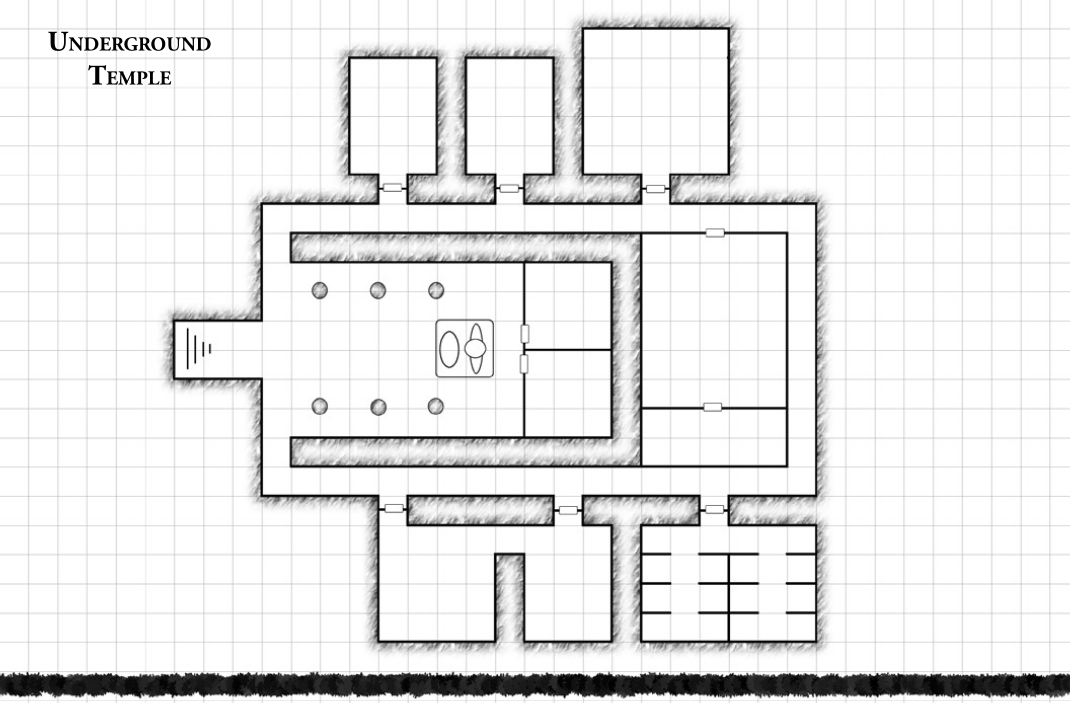
Maps are all like this, with lots of white space. GMs are meant to get them dirty and scribble all over them.
And that's it for Red Tide, thanks for reading!